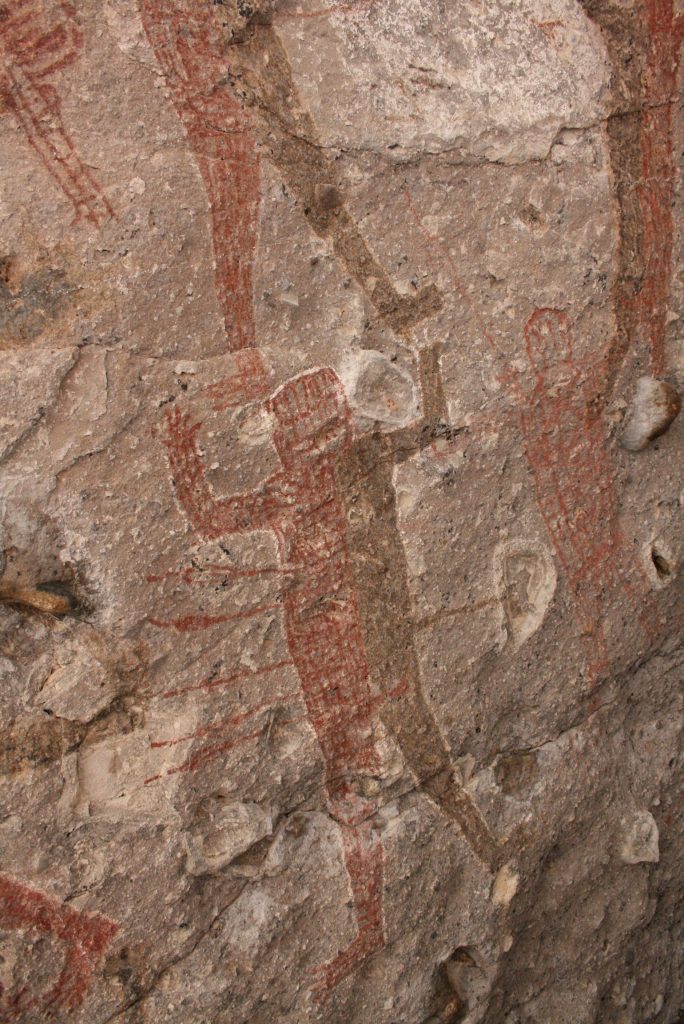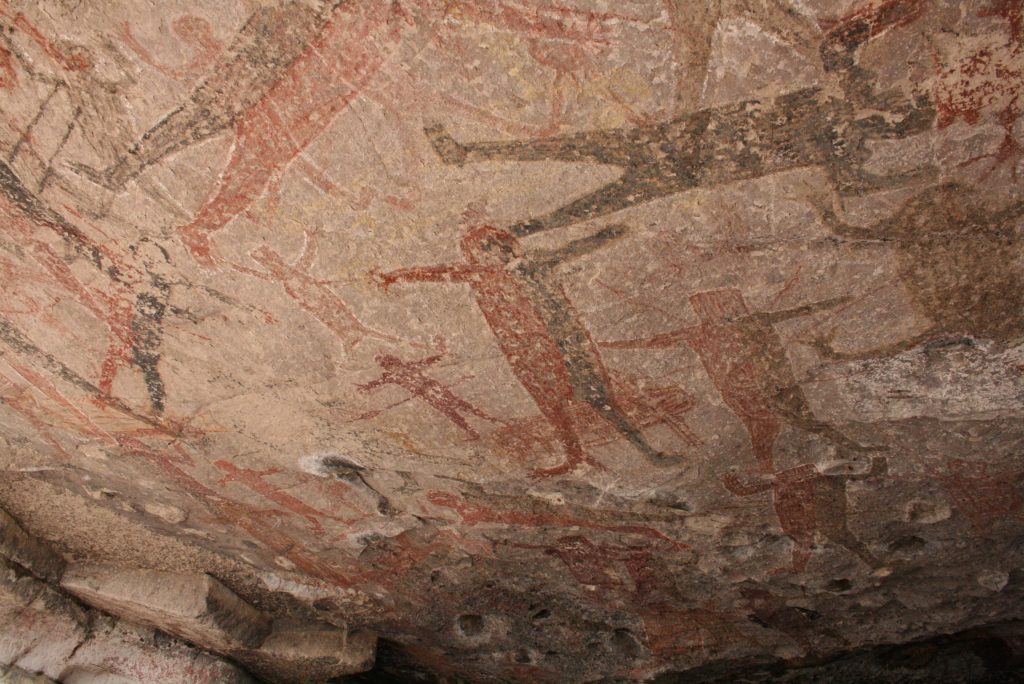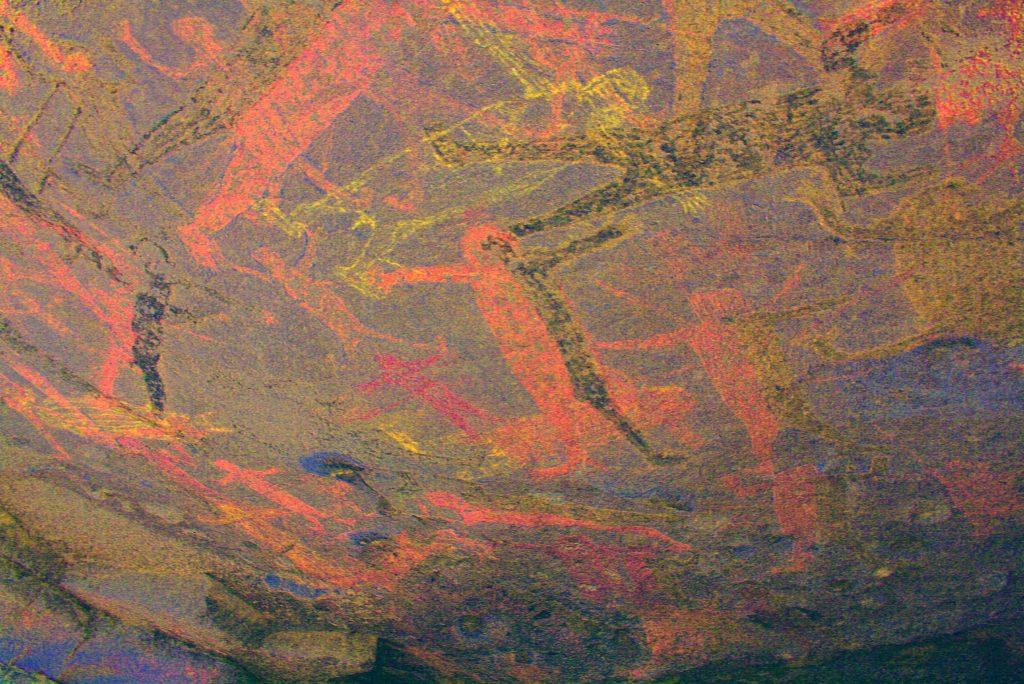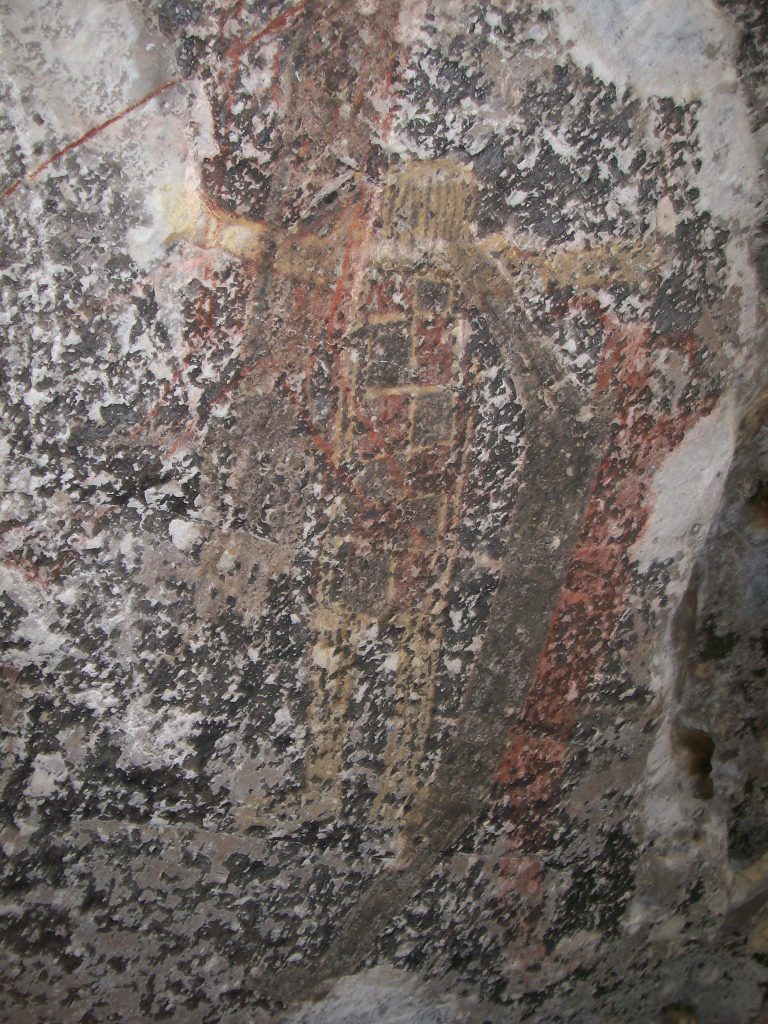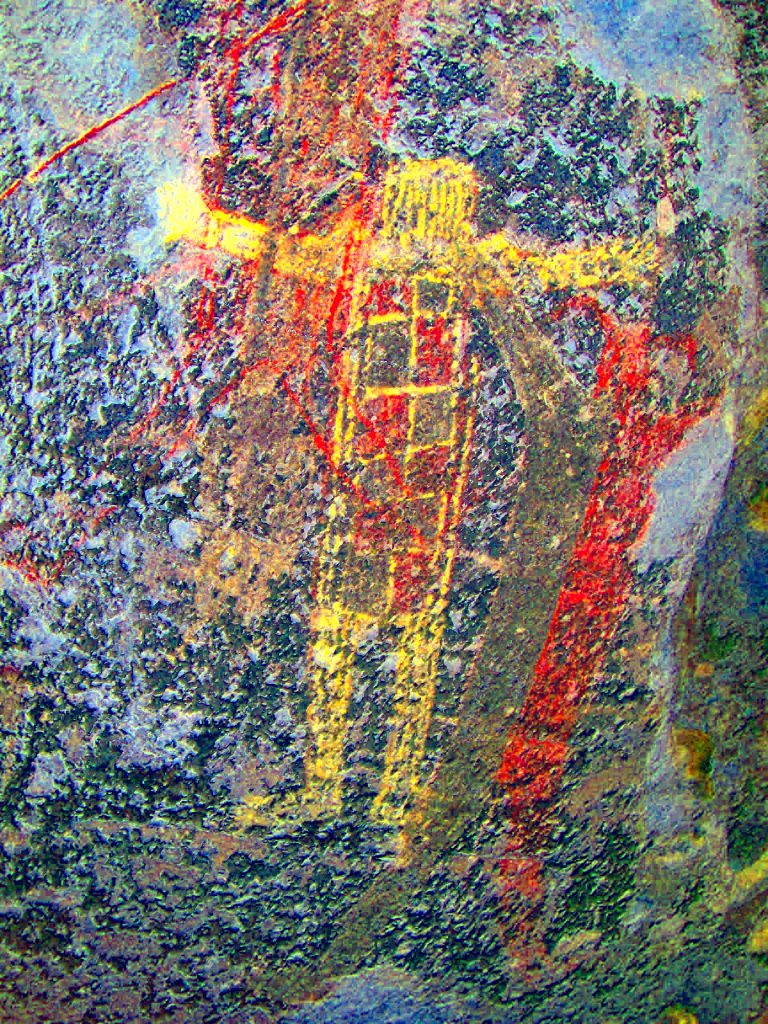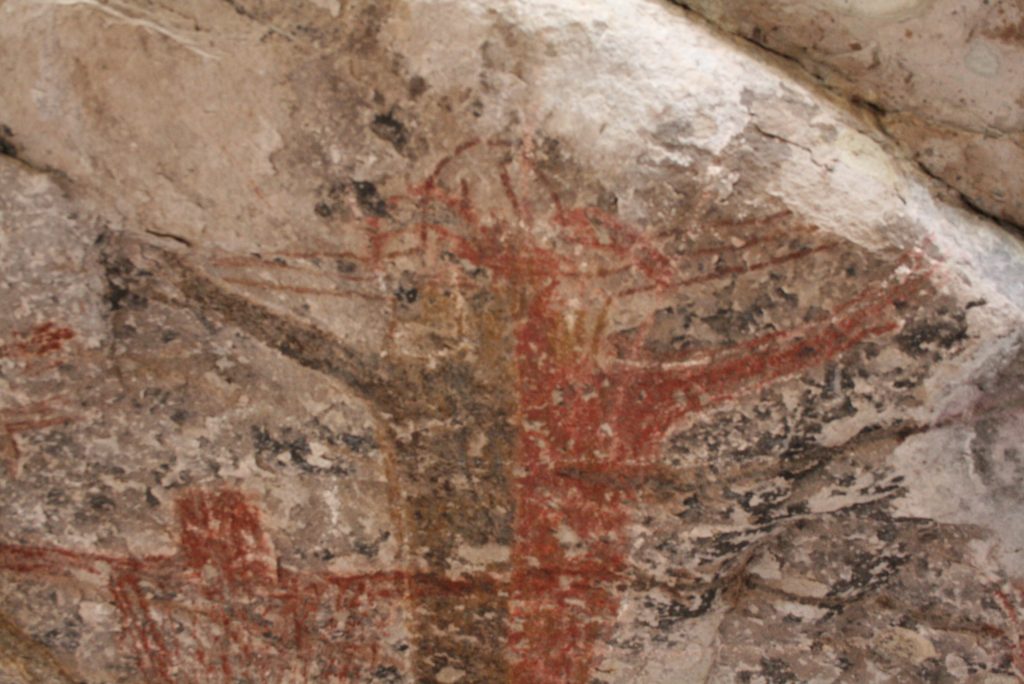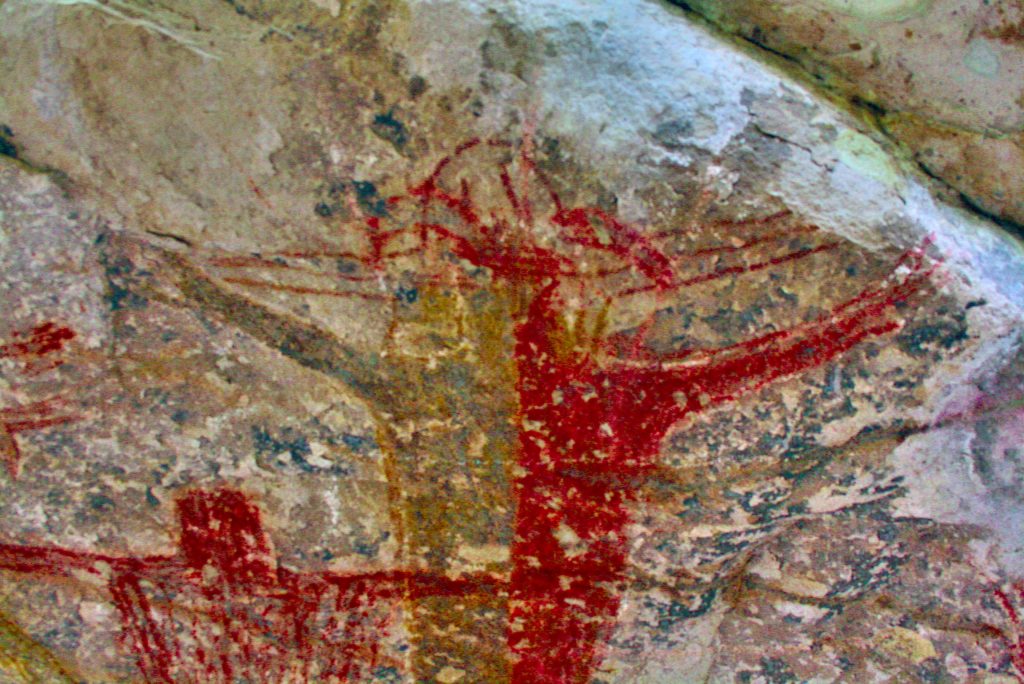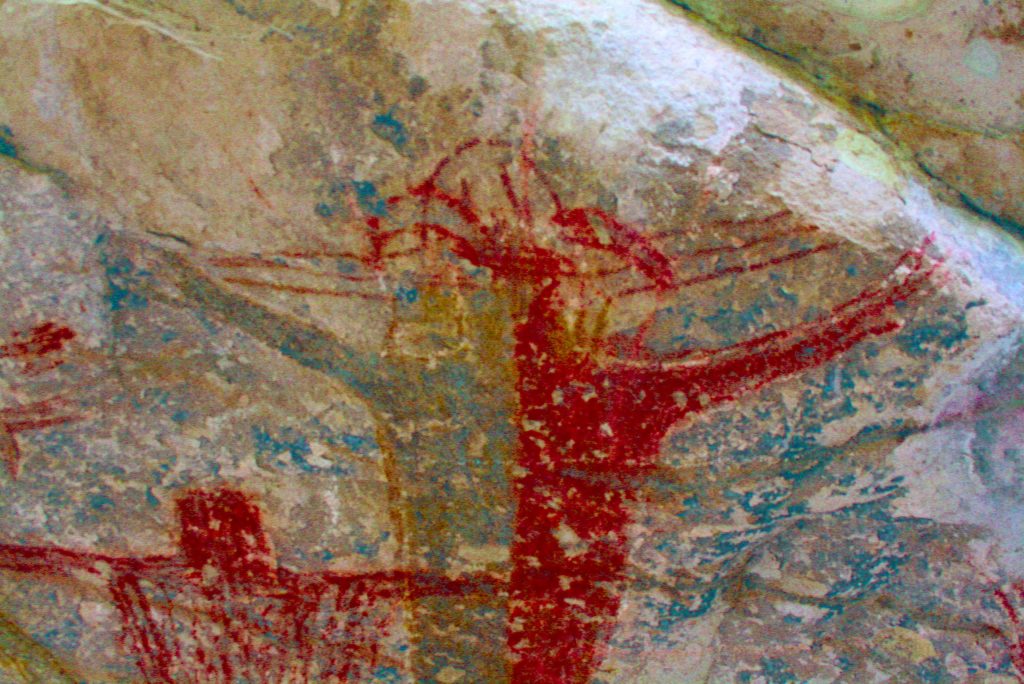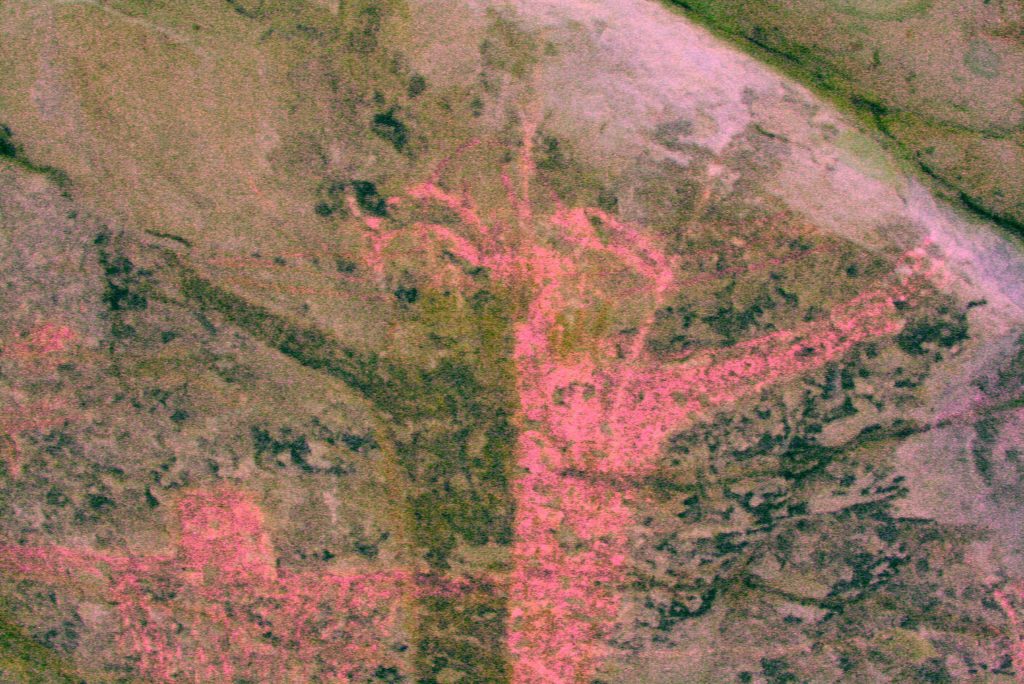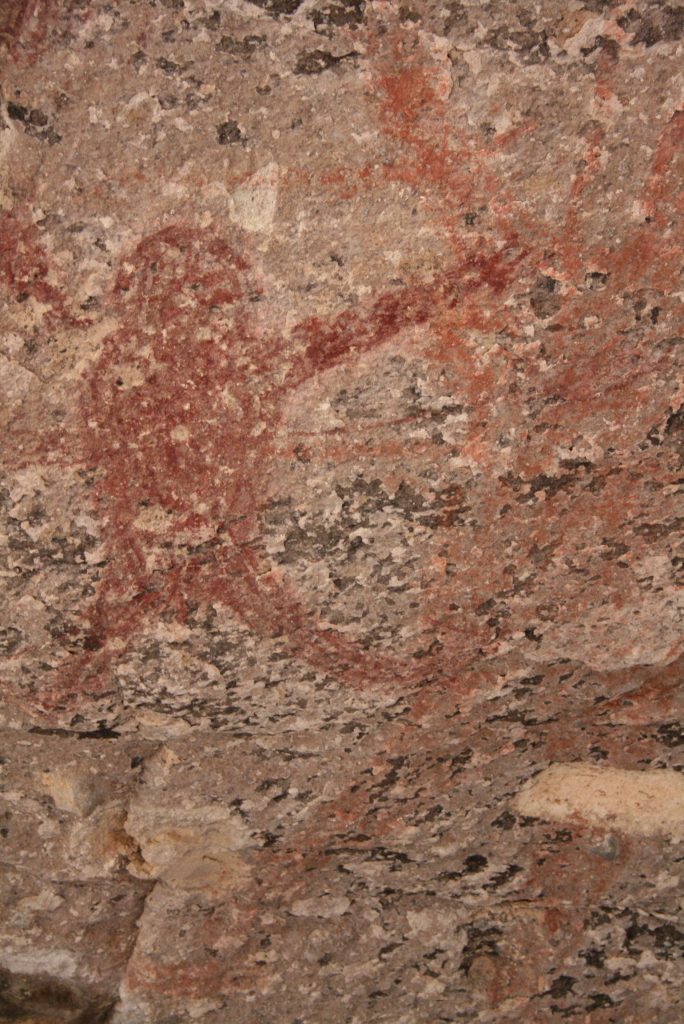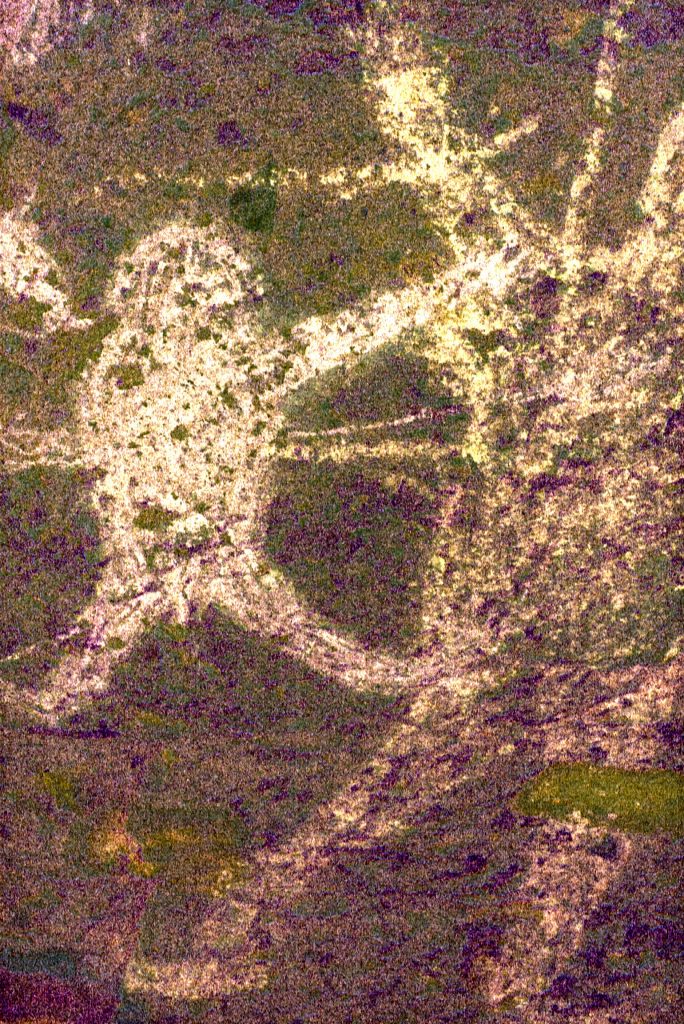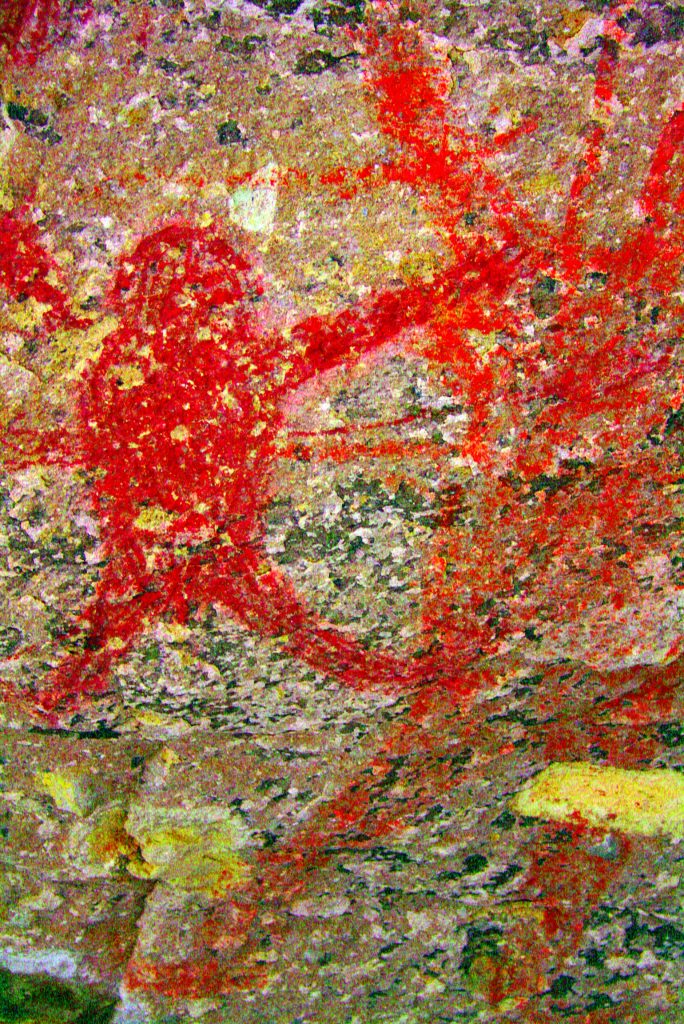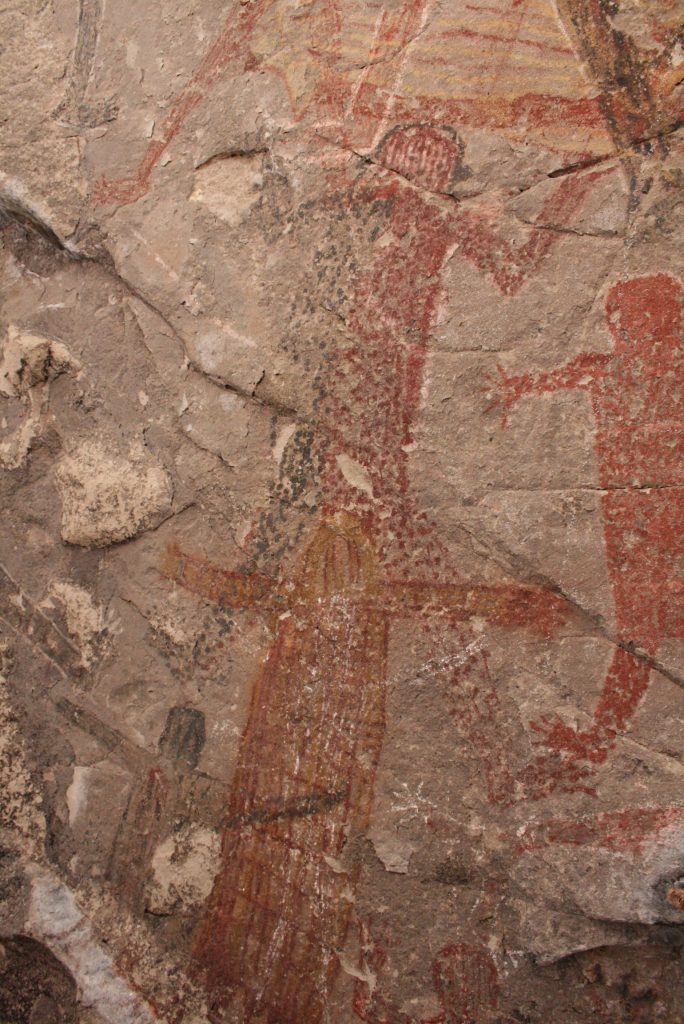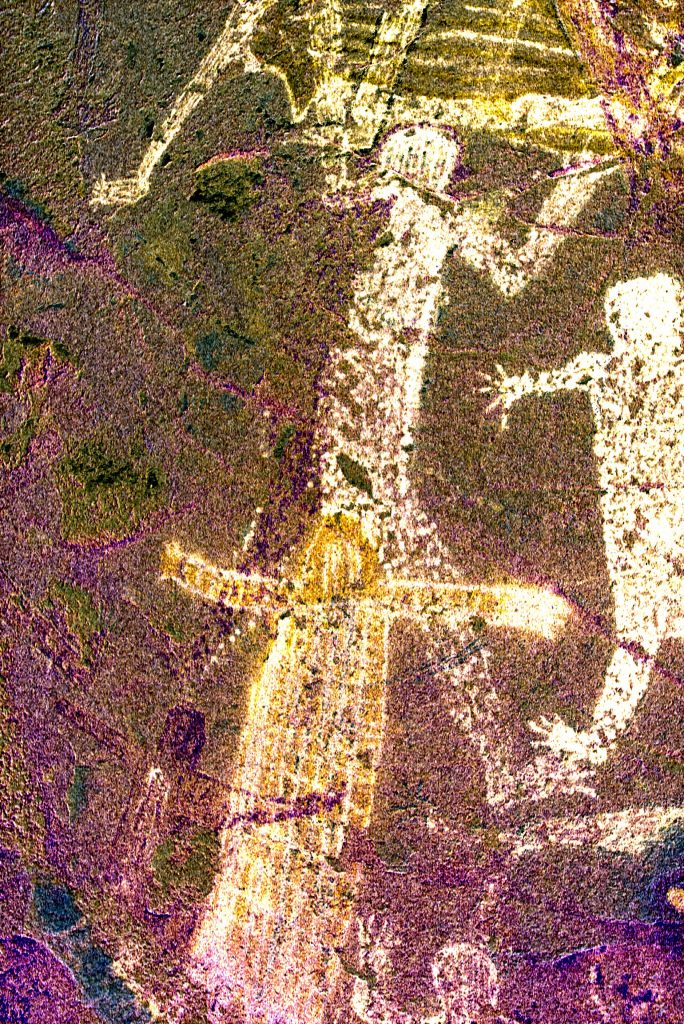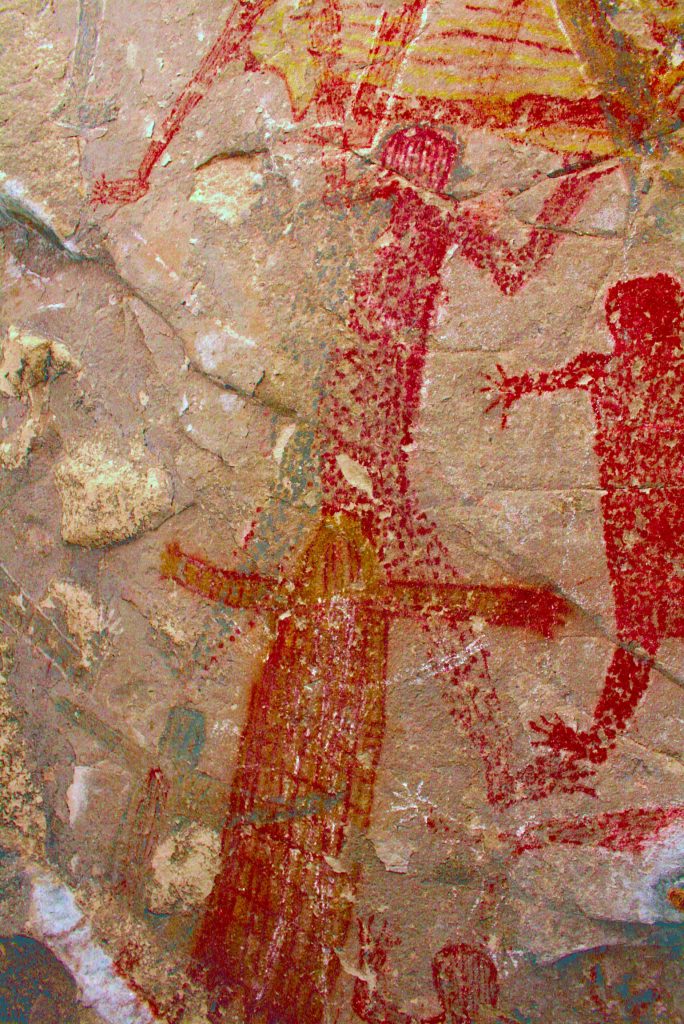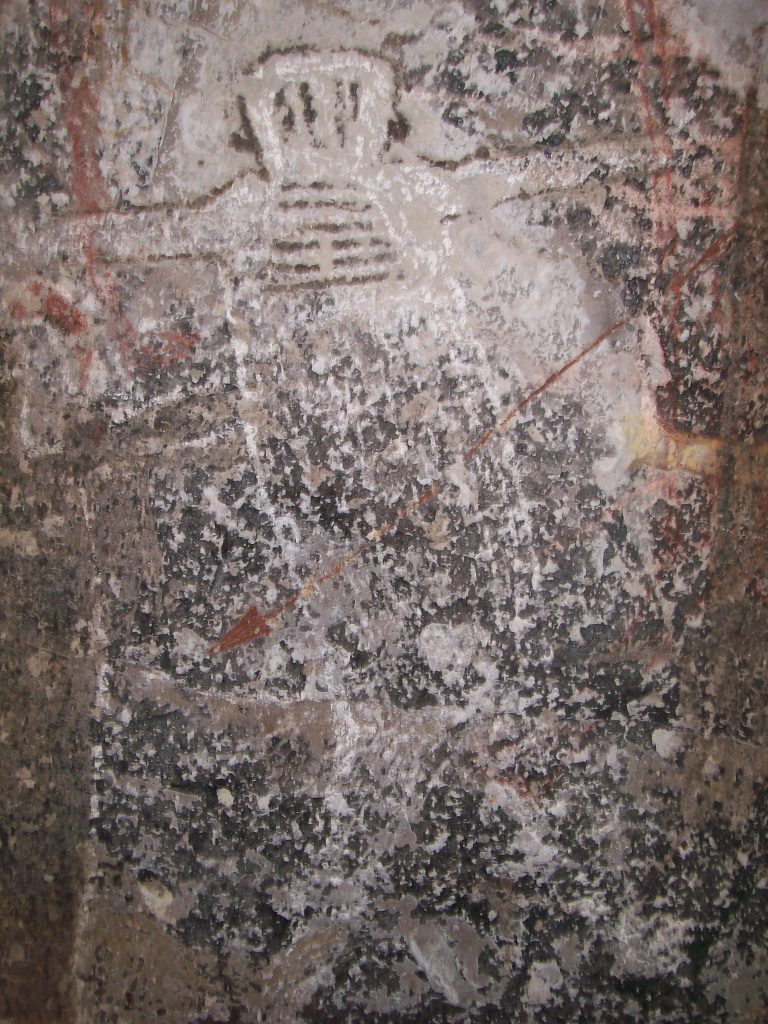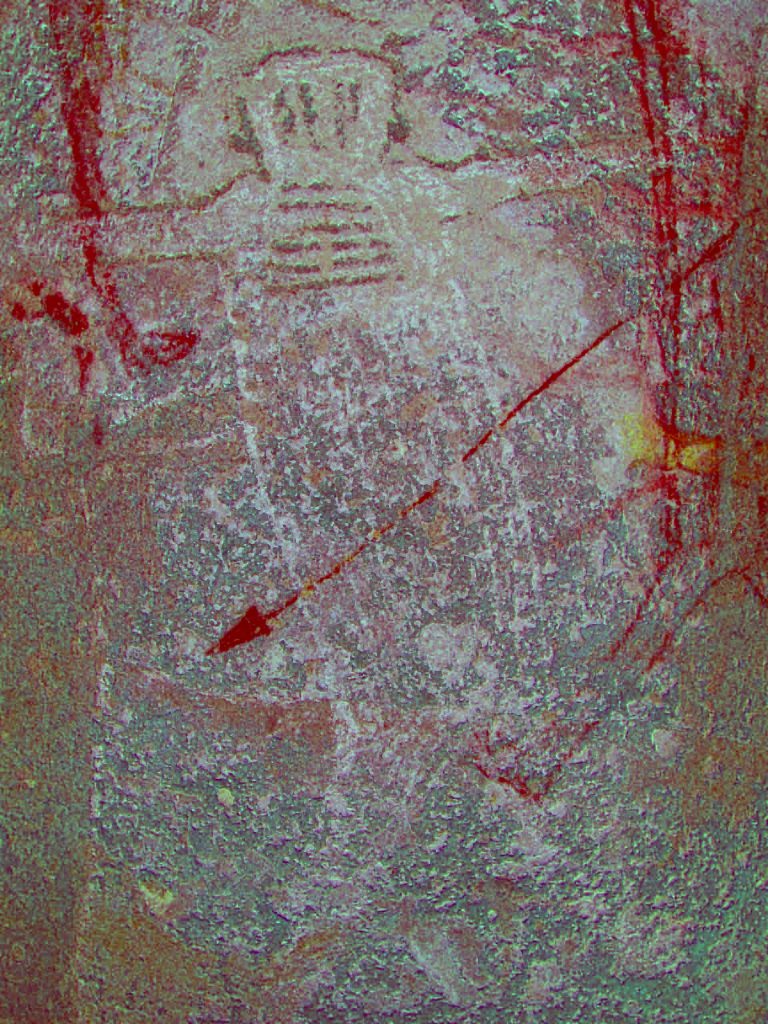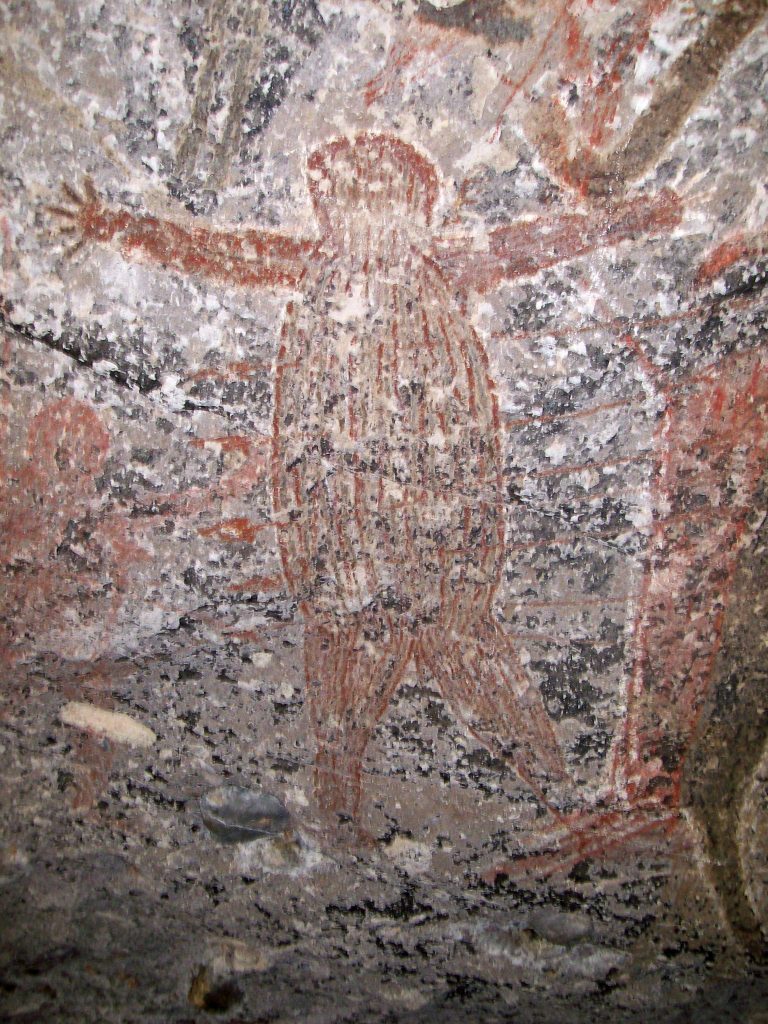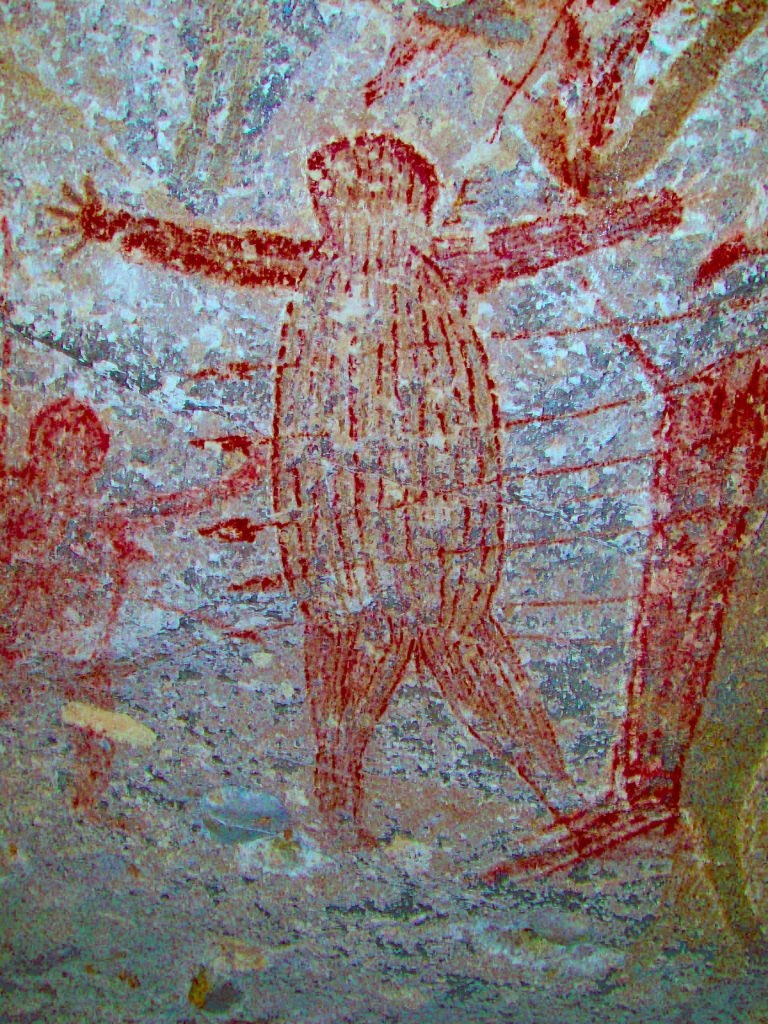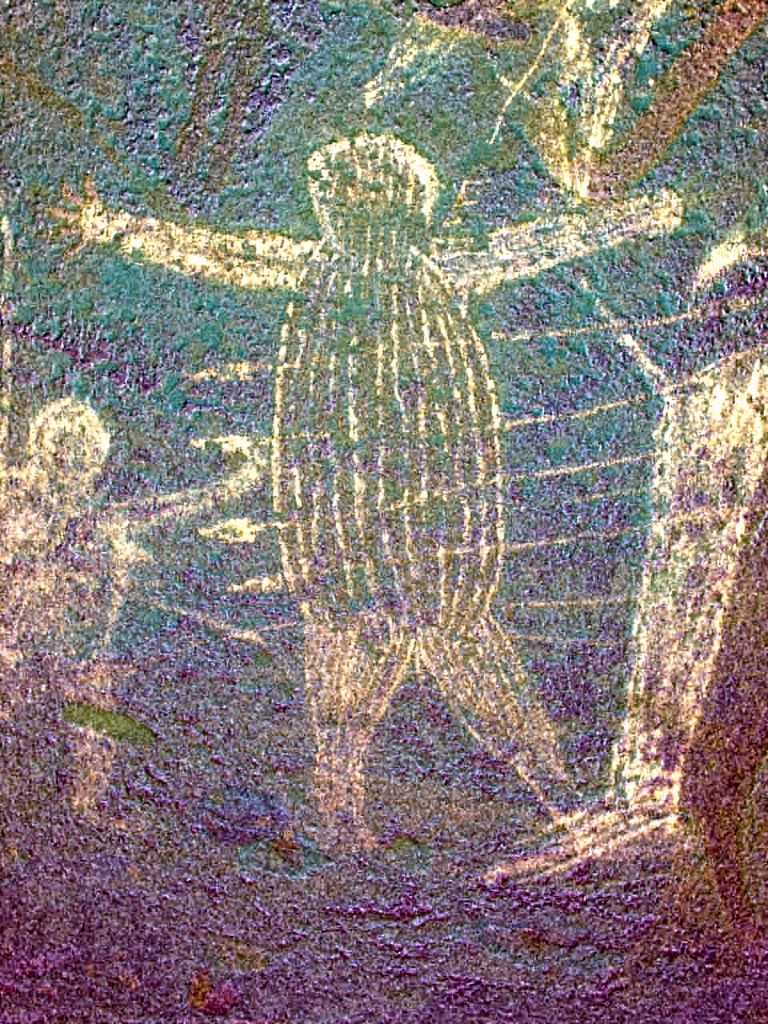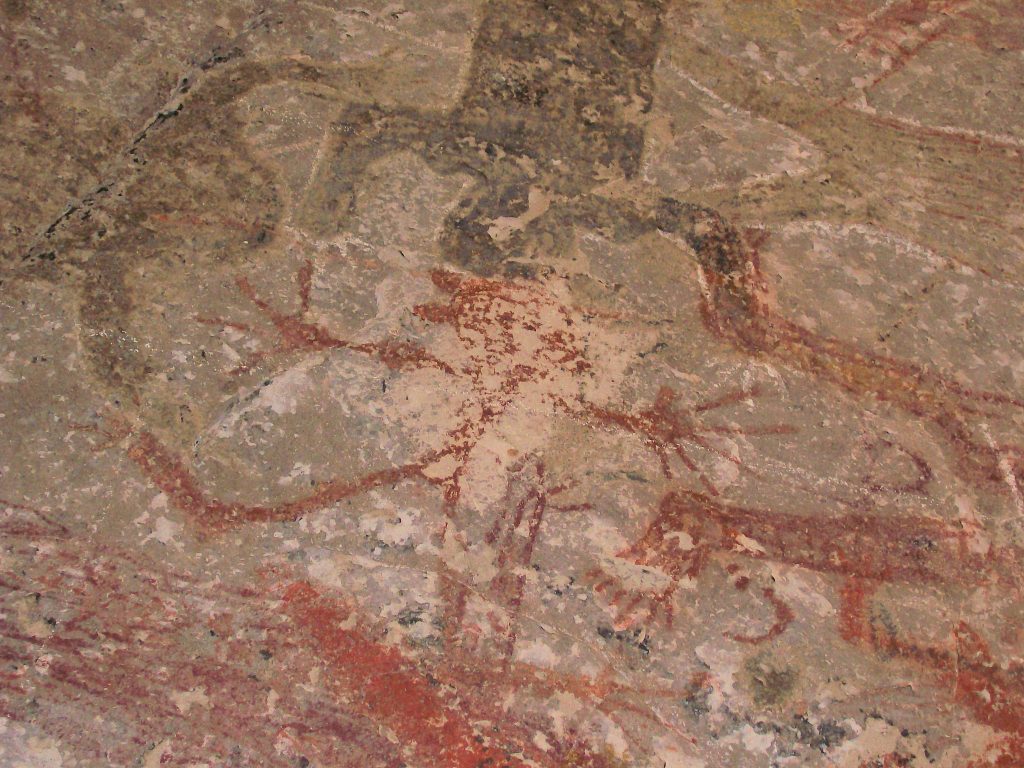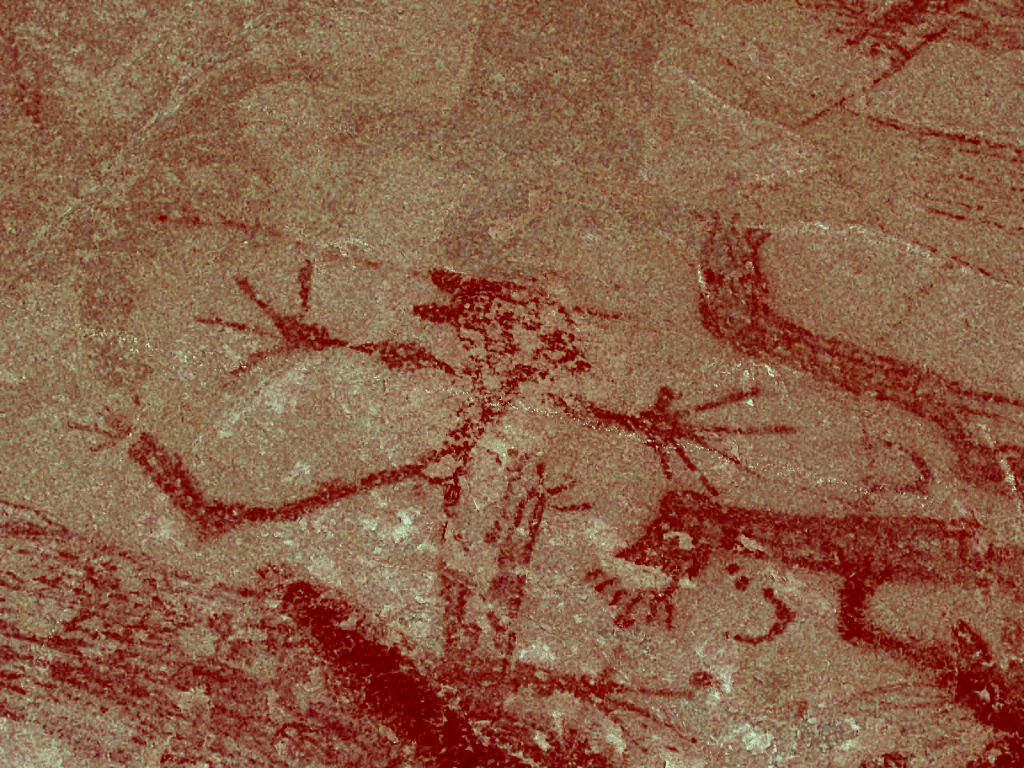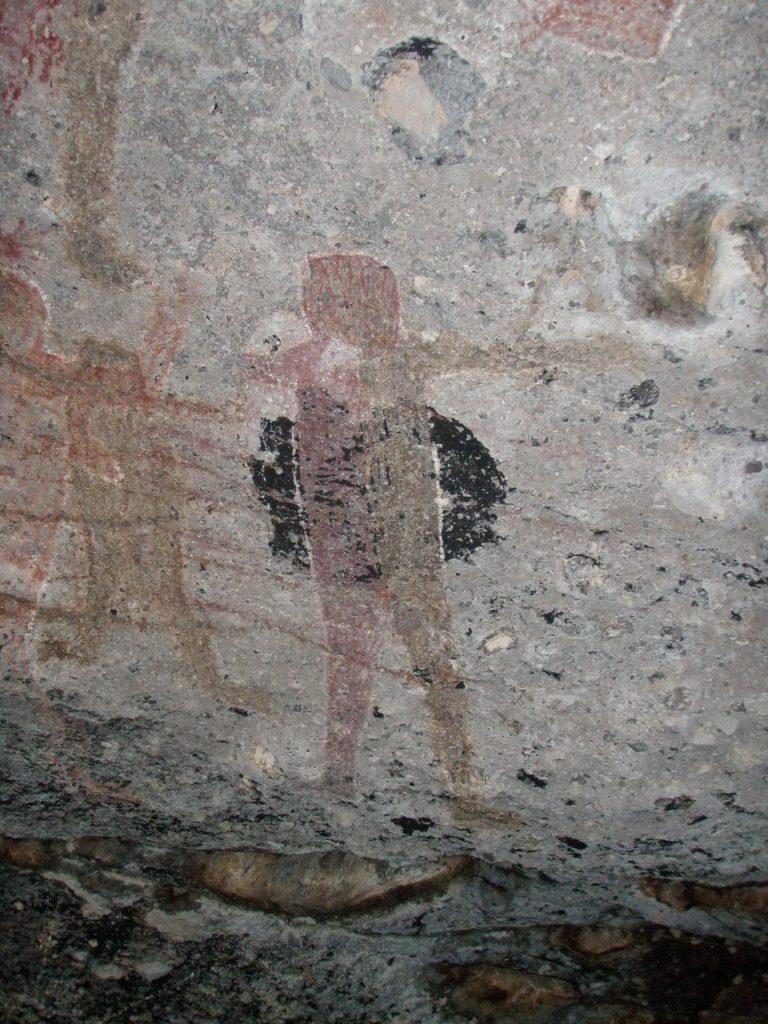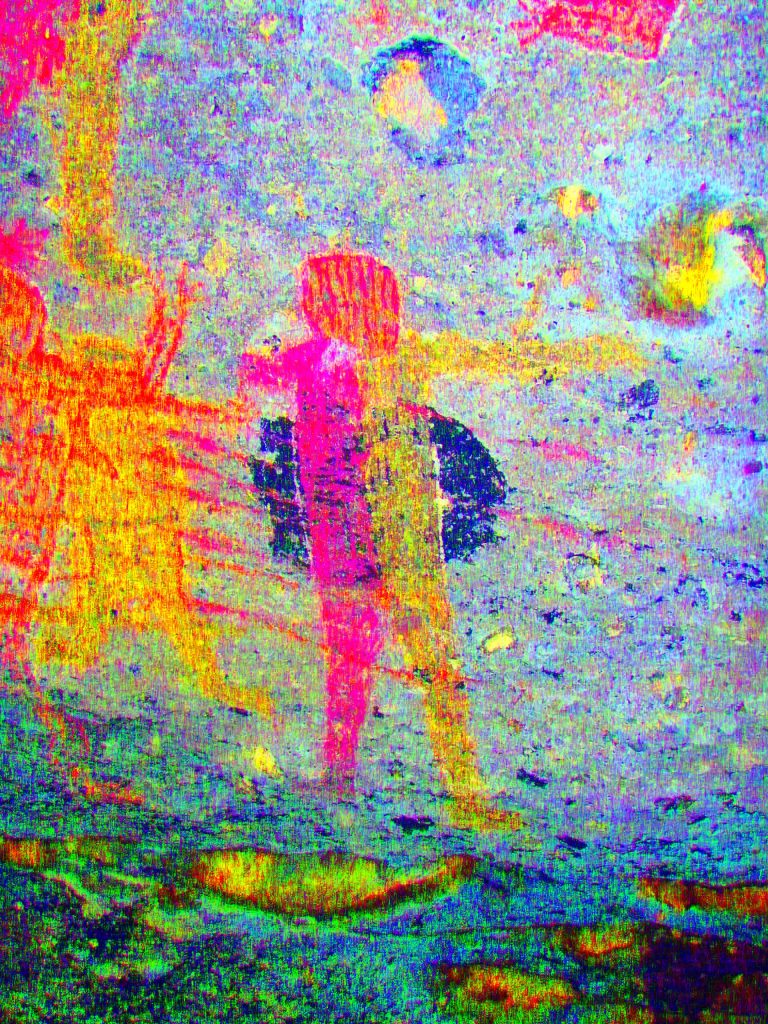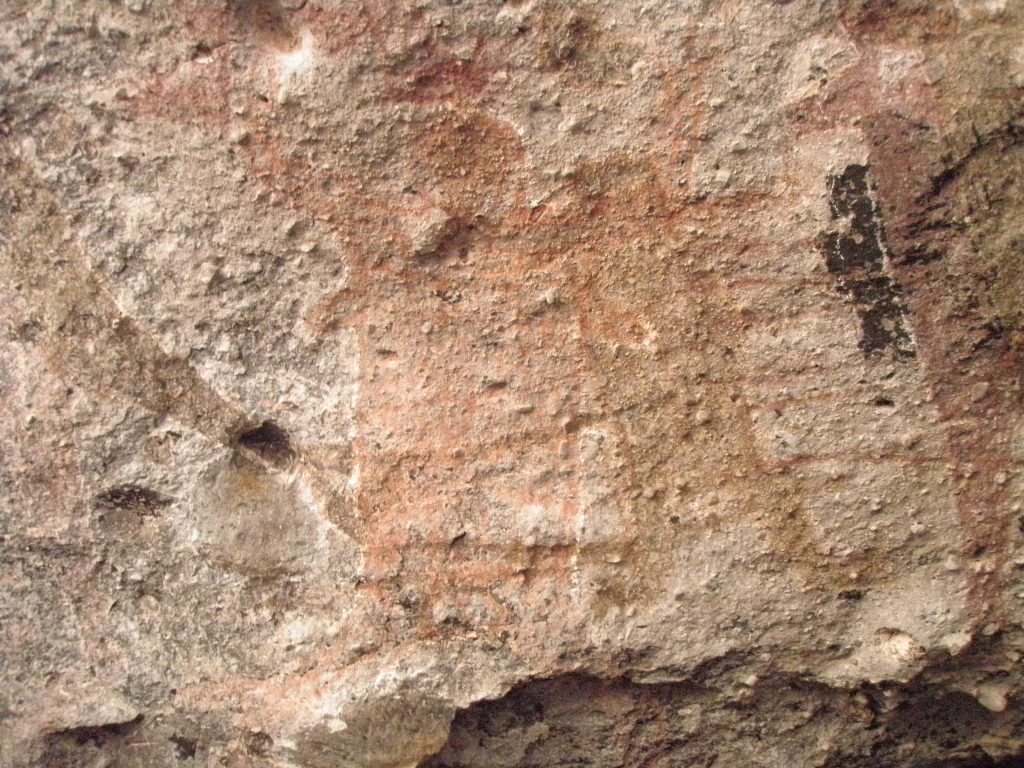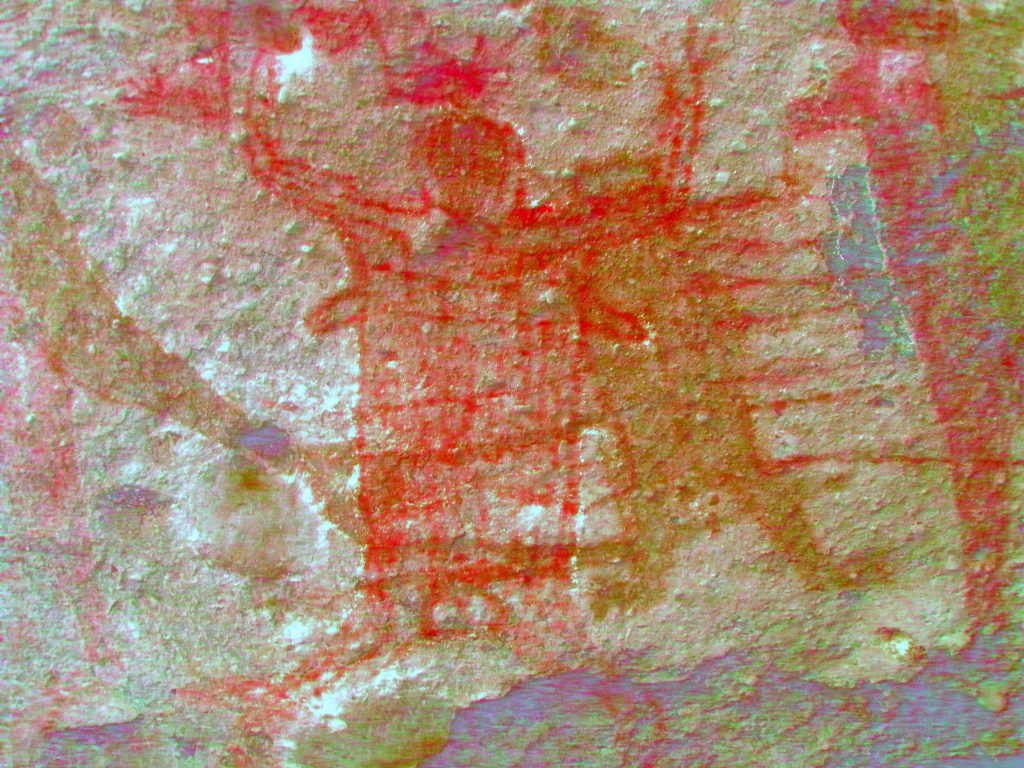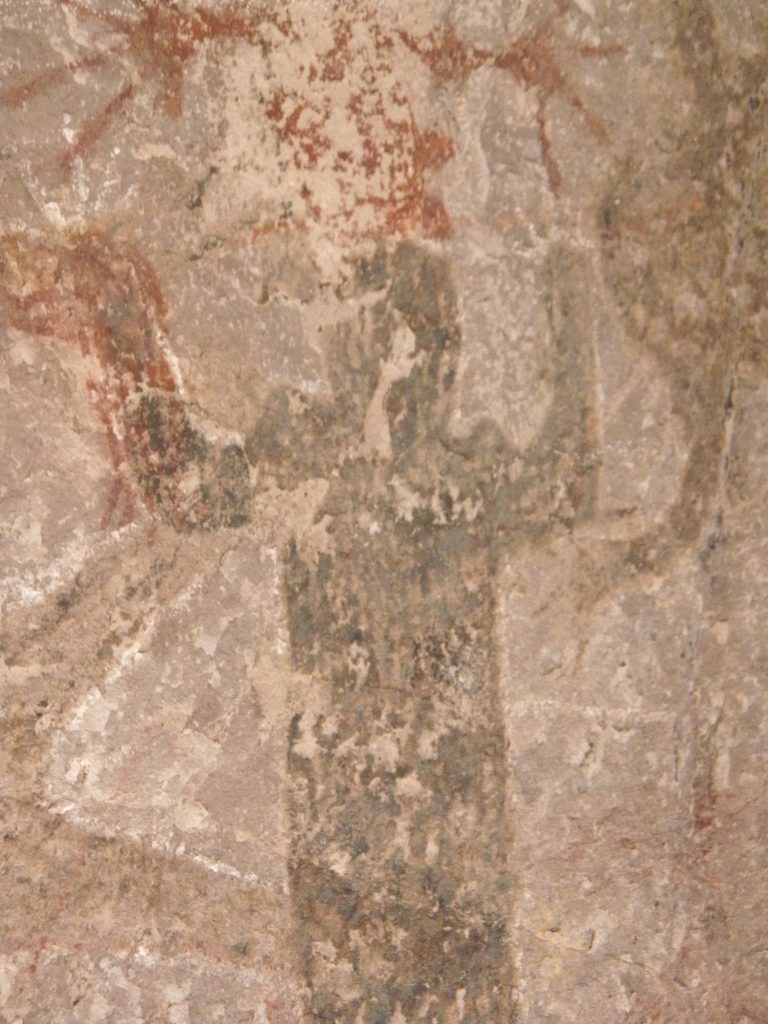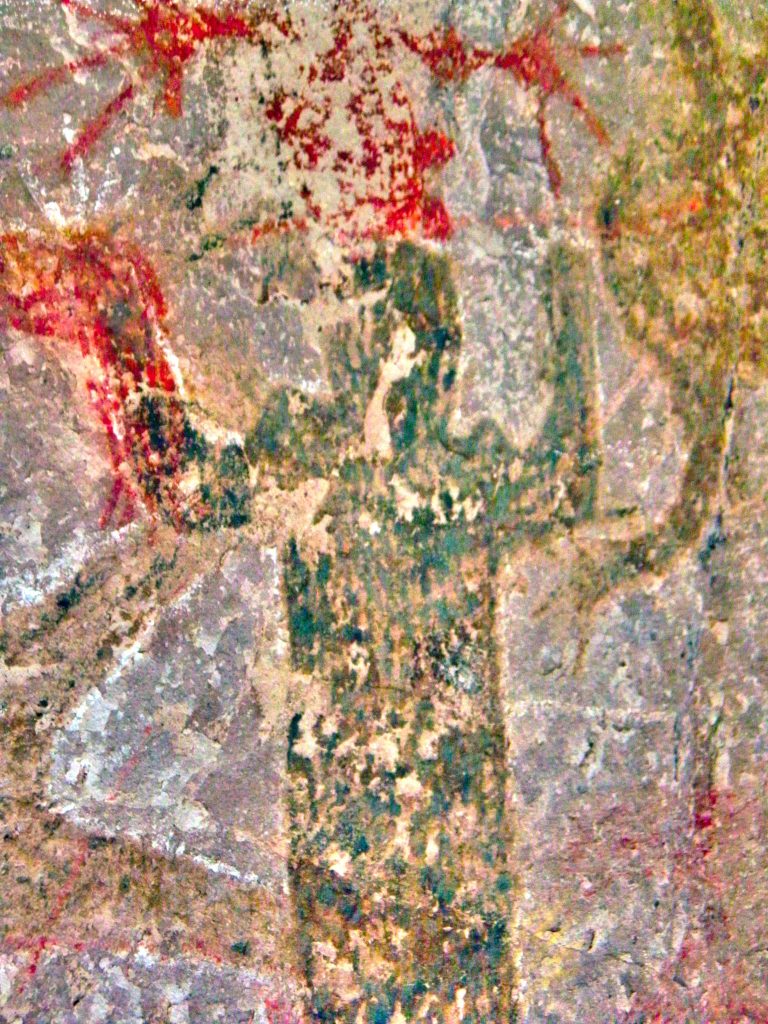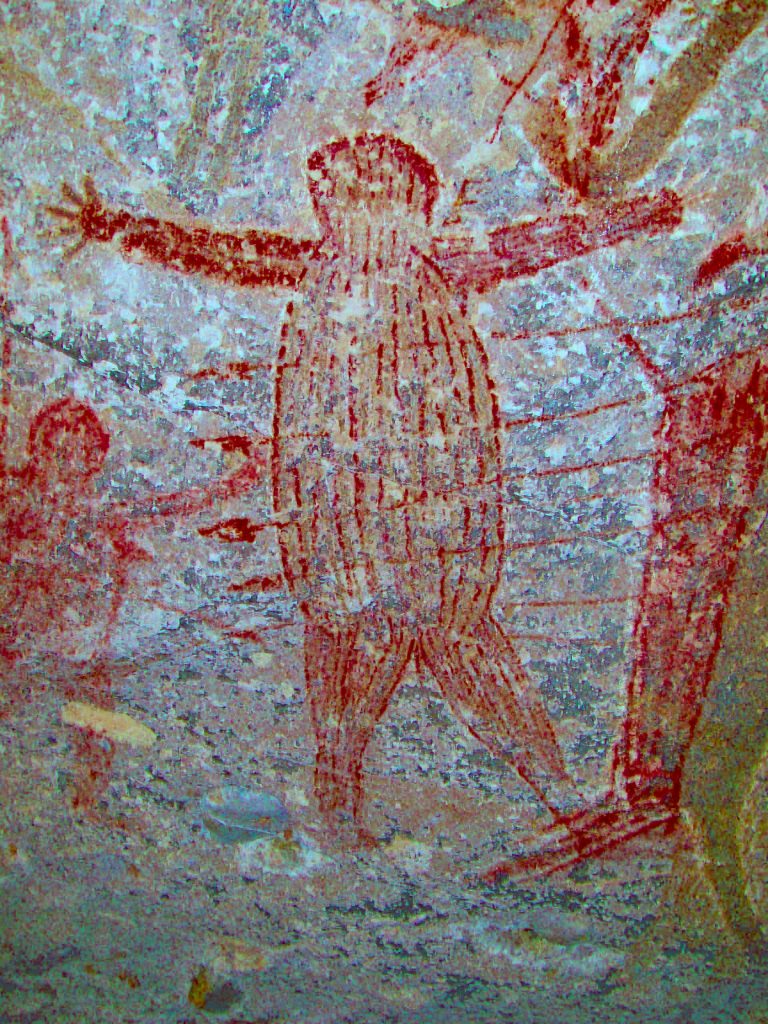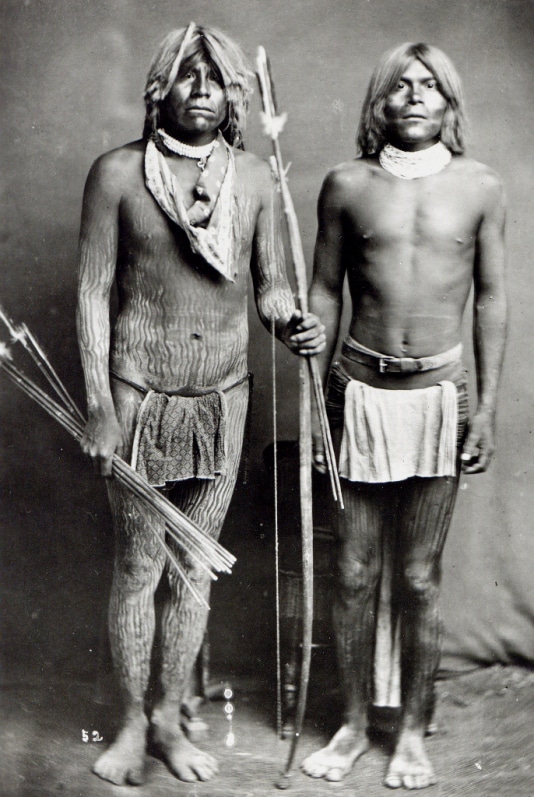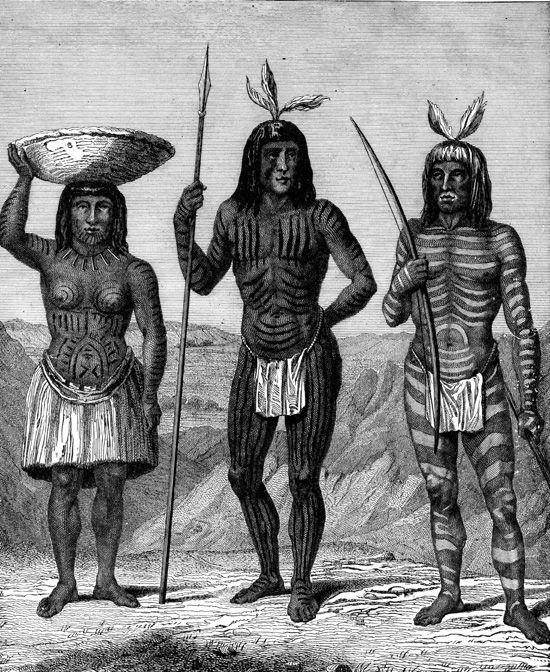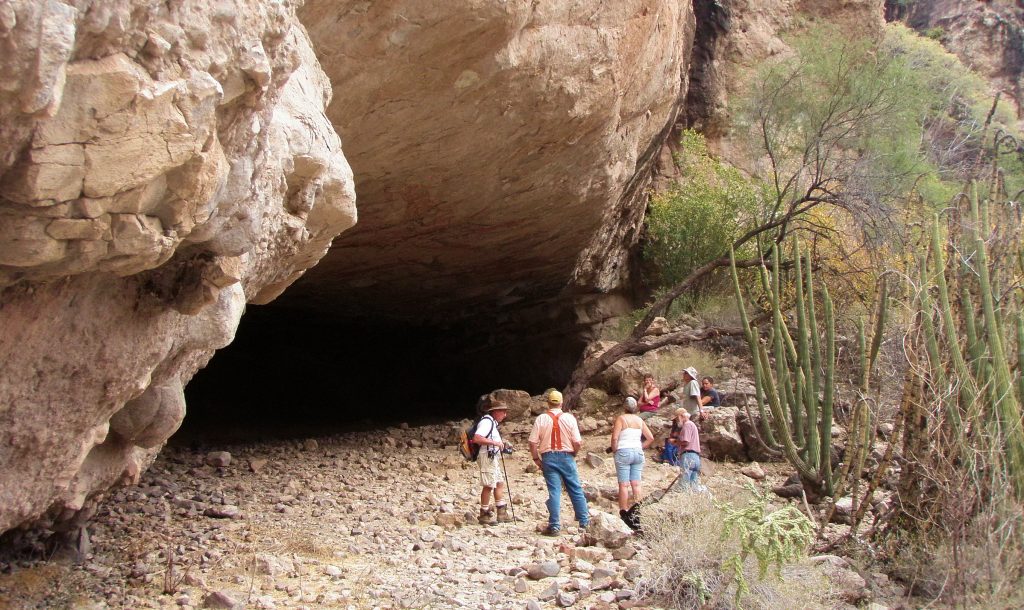
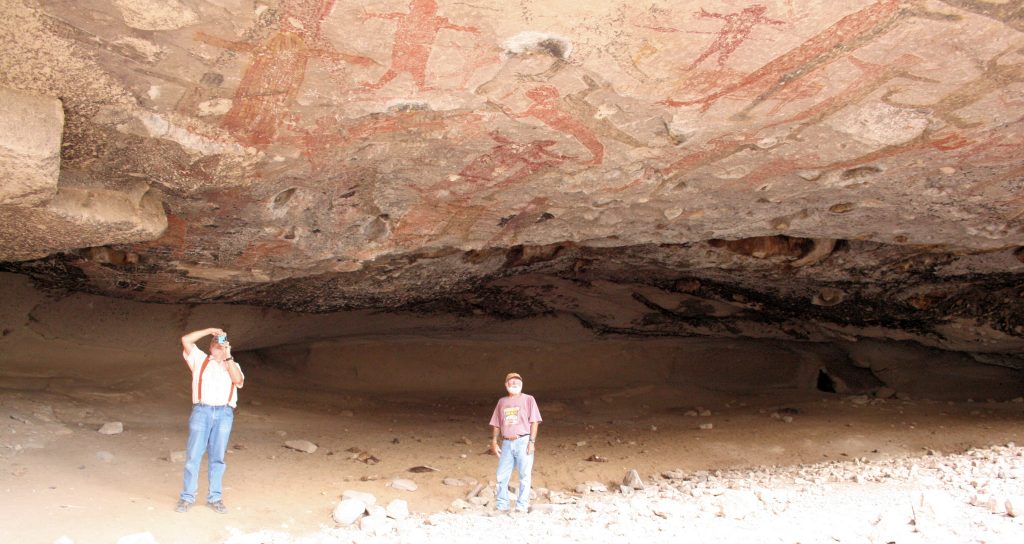
The photo above give you a reference for the size of the pictographs compared to the visitors below.
Above left is photo B 13. On the right is the same photo enhanced by the D-Stretch method B 13_lab_ac. In the descriptions and photos that follow I will usually show an un-retouched photo and the enhanced photo to show extra details. I will describe what is shown. I will try not to editorialize and attribute meaning to what is shown. . . only the painters can do that! But hey, I get carried away sometimes so please forgive.
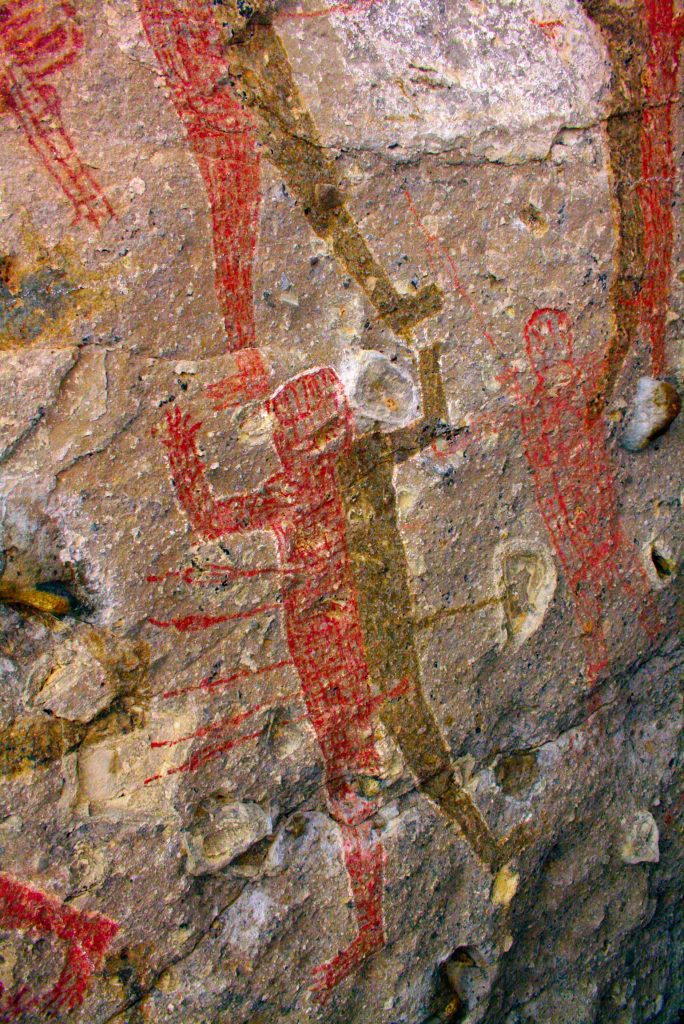
This cave is well documented as to art work and contains mostly large Anthropomorph figures and some vulva petroglyphs. The monos are positioned with heads facing different directions; some north, some east and some west, none facing south. Some women but mostly men. Some monos have outstretched arms compared to upturned arms. Most monos have black on one side and red on the other, some have the left side black some the right.
On the side painted black, the fingers and toes are usually blocked out or missing. Whereas the red painted side clearly shows digits on hands and feet. This figure has what I call a “can head” The body is pierced with arrows or atlatyl darts. The figure has been outlined in white, either before or after the figure has been painted. The arms are UPstretched. Longitudinal lines in body.
photo B 13_lab_ac by author
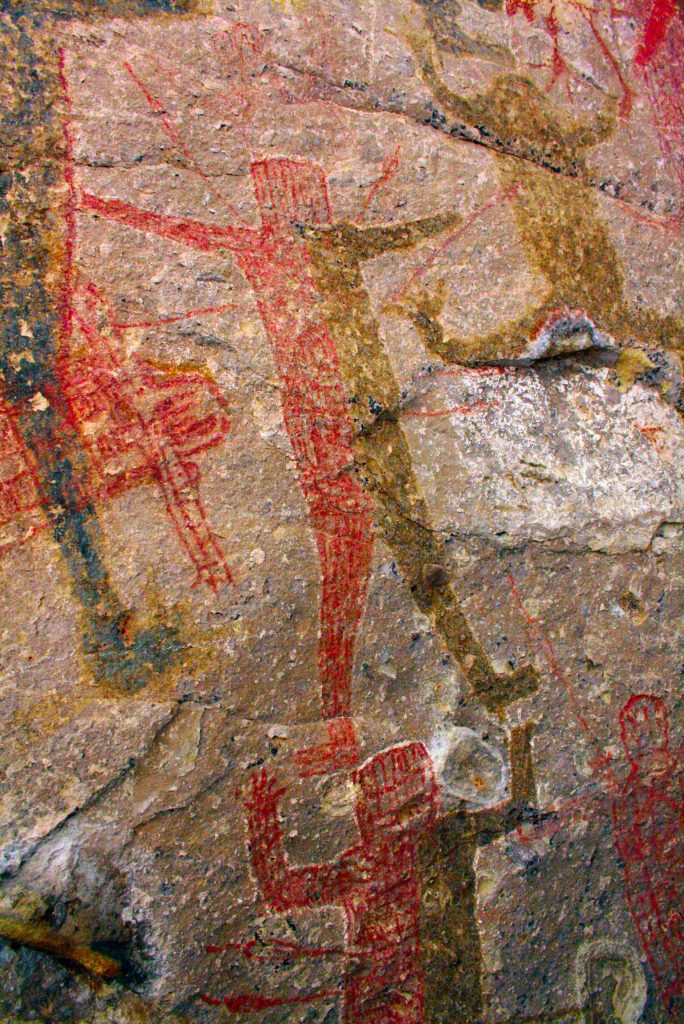
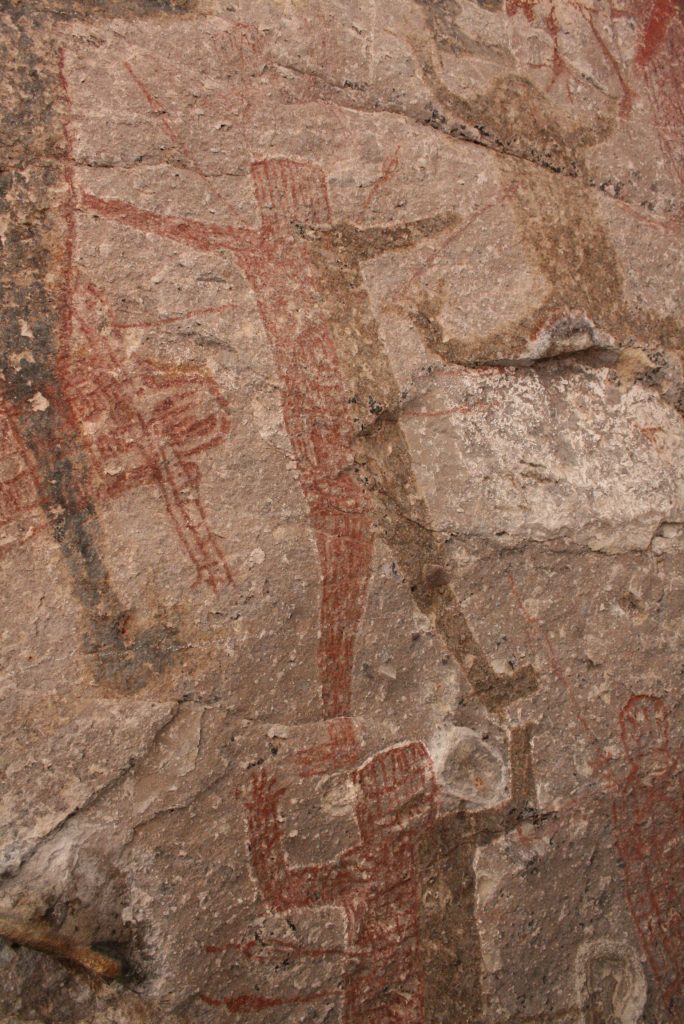
The above photo on the right, B 14_lab_ac, shows a similar Mono with can head and black on his left side. This one shows OUTstretched arms. The toes are missing on the black foot. There are pronounced “bumps” on the shoulders.
Paintings at this site have been Carbon 14 dated to 7500 years before present
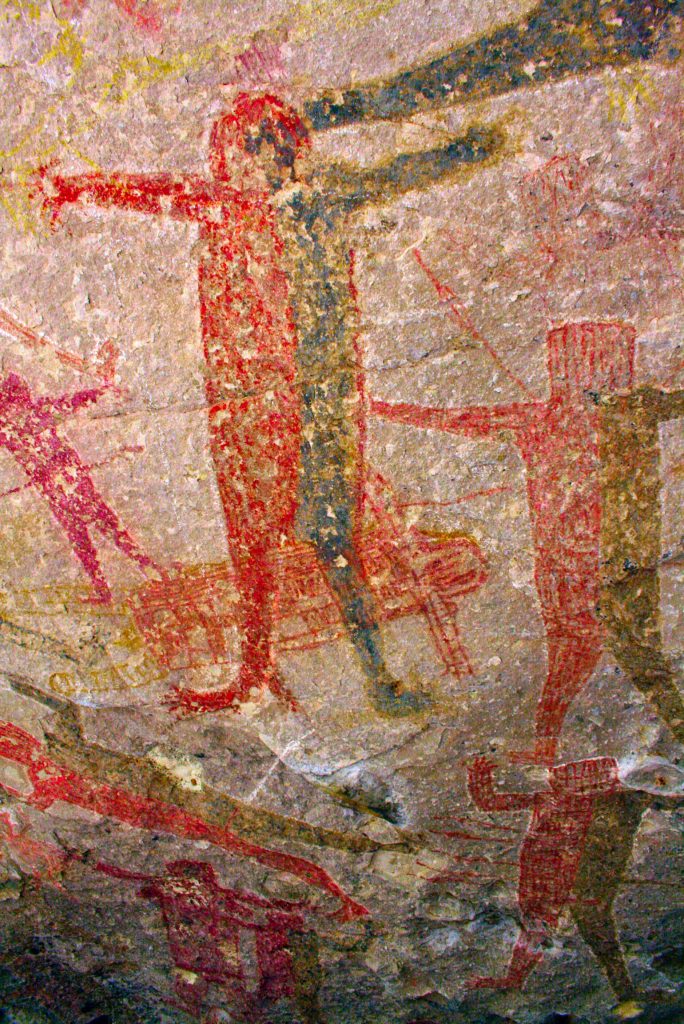
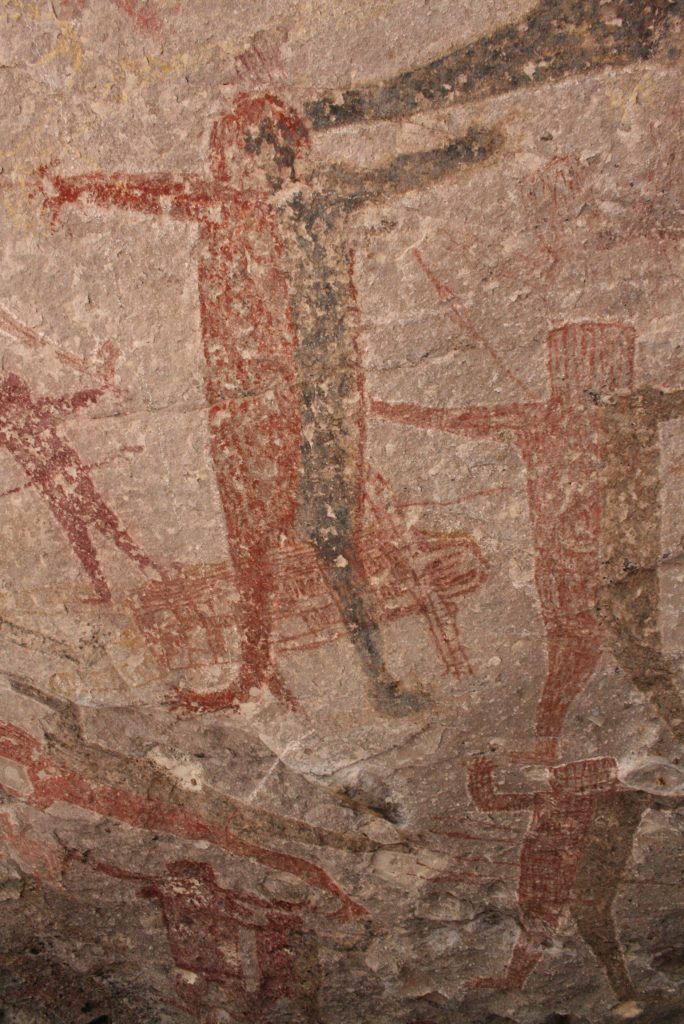
A “round head” figure in B 16_lab_ac. Toes visible on right foot. Black dots in face area. Notice that the whole figure has had chips broken out of it as if it had been hit hard by something capable of removing lumps of stone.
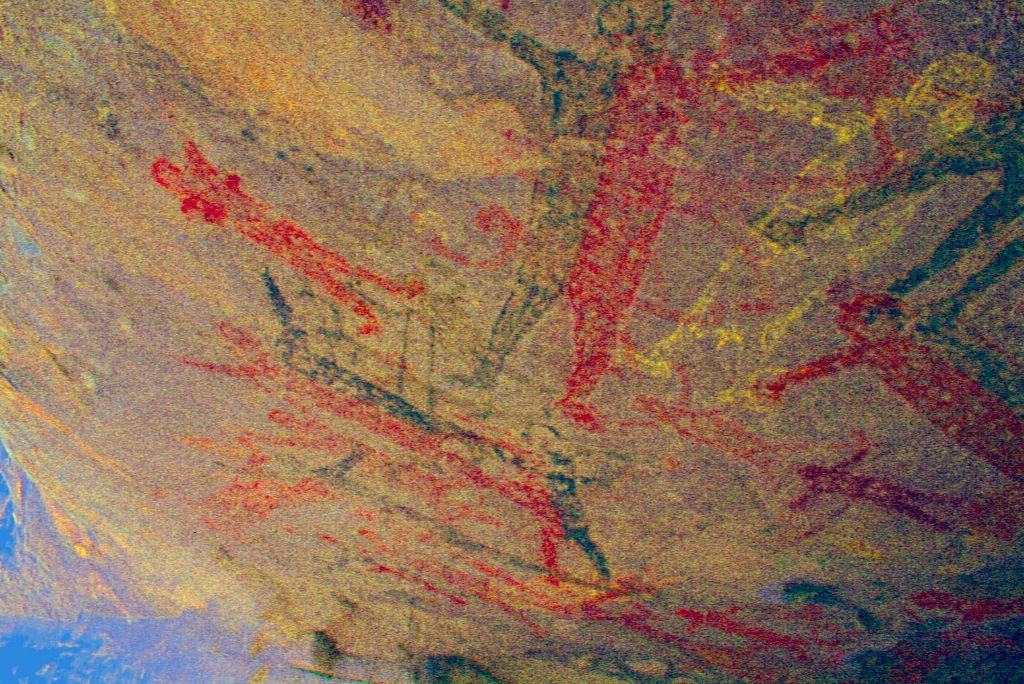
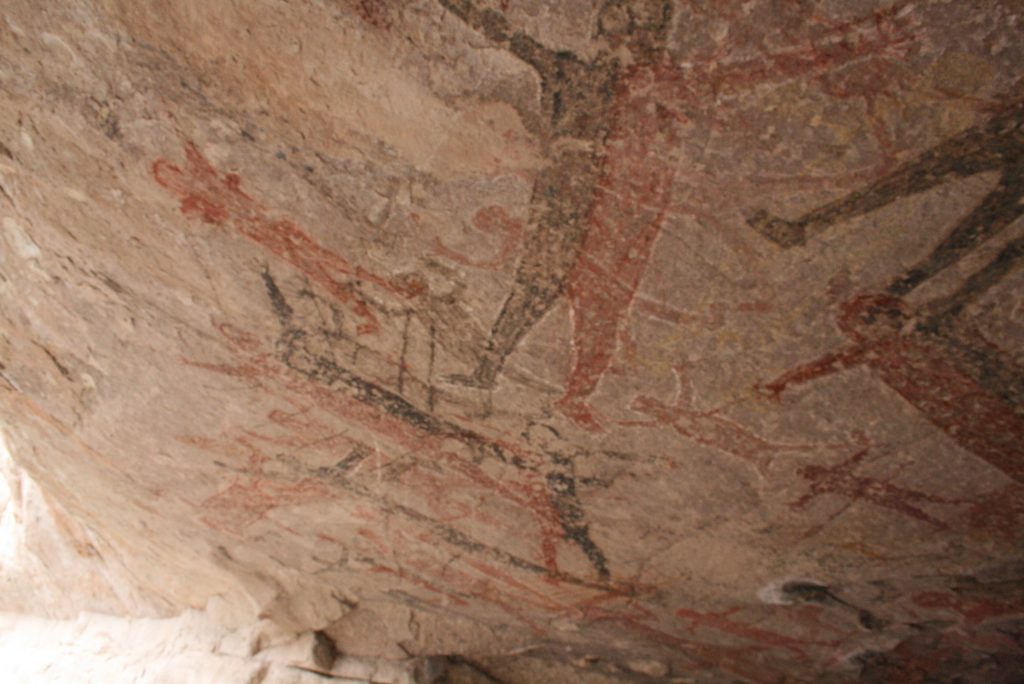
The photo B 17 on the left shows a general view of part of the roof of the cave. However, B 17_lds above right shows a ghost image not visible in the un-retouched photo. Here you can see a mono in yellow that otherwise would have gone un-noticed. I never saw it till the photo was enhanced! Notice also that many figures have been painted over with other monos and in some cases those figures have been overpainted again.
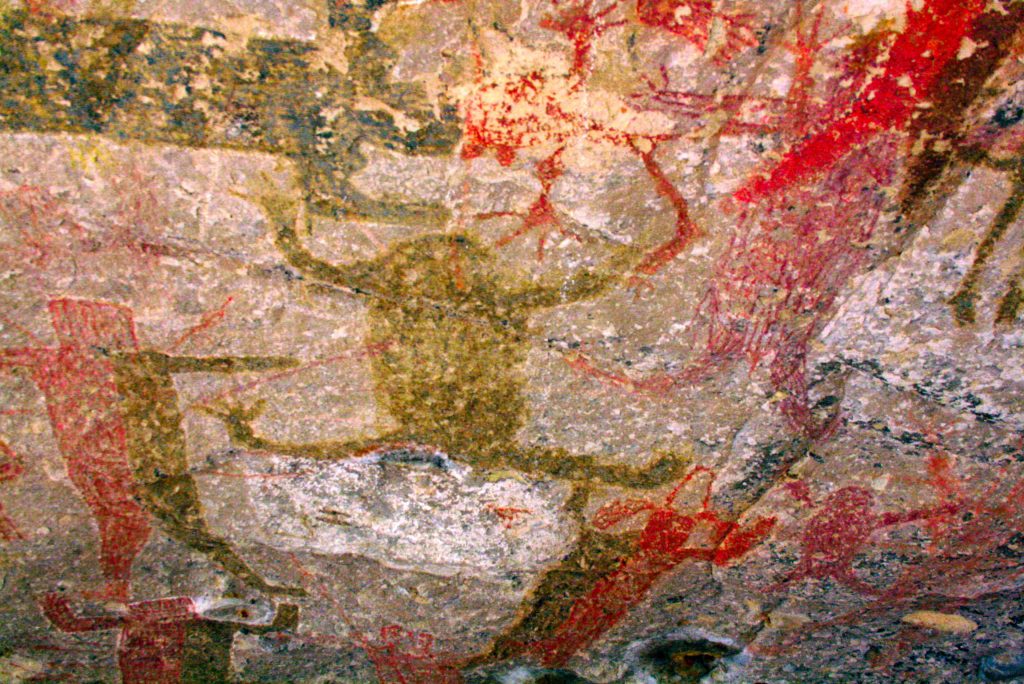
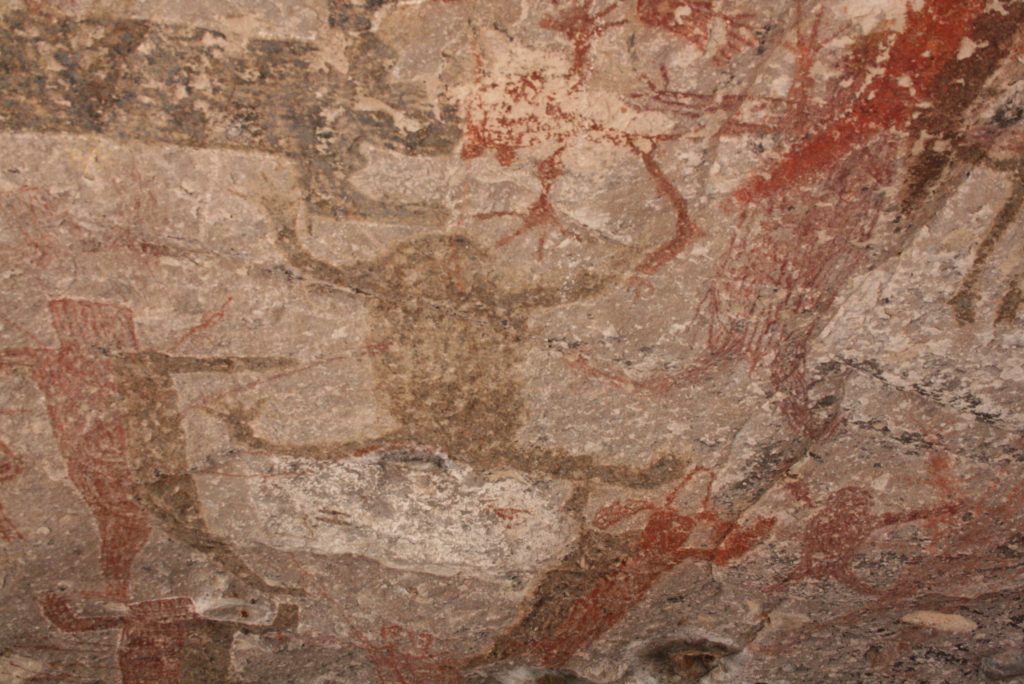
This mono is unusual in as much as it is the only one portrayed with the legs splayed out to either side. Body totally black. Round head with ‘bump’ on left arm in elbow region. Digits shown on right arm and foot only. Again, chips of rock hammered out of the image. The presence of the white colouring of the rock below the figure may be accidental?
Photo B 19 on the left, B 19_ybk on the right is another general view where the yellow ghost mano is captured again. “Yellow man” has an obvious phallus and appears to have a bandolier shaped marking on the torso.
Photo B 44 on left and B 44_ac_lrd on the right, shows a Yellow mono with a can head, outstretched arms and a checkerboard pattern on the torso. Some of the checkerboard squares have red coloured items showing. Notice the pronounced bumps on the shoulders. On the viewers right is a black-red mono with “floppy ear” style of headdress.
The above photo B 23 and it’s enhancements show a black-red mono with floppy ear headdress overpainted on a mono with “ghostbuster eyes.” Darts or arrows pierce one of the figures.
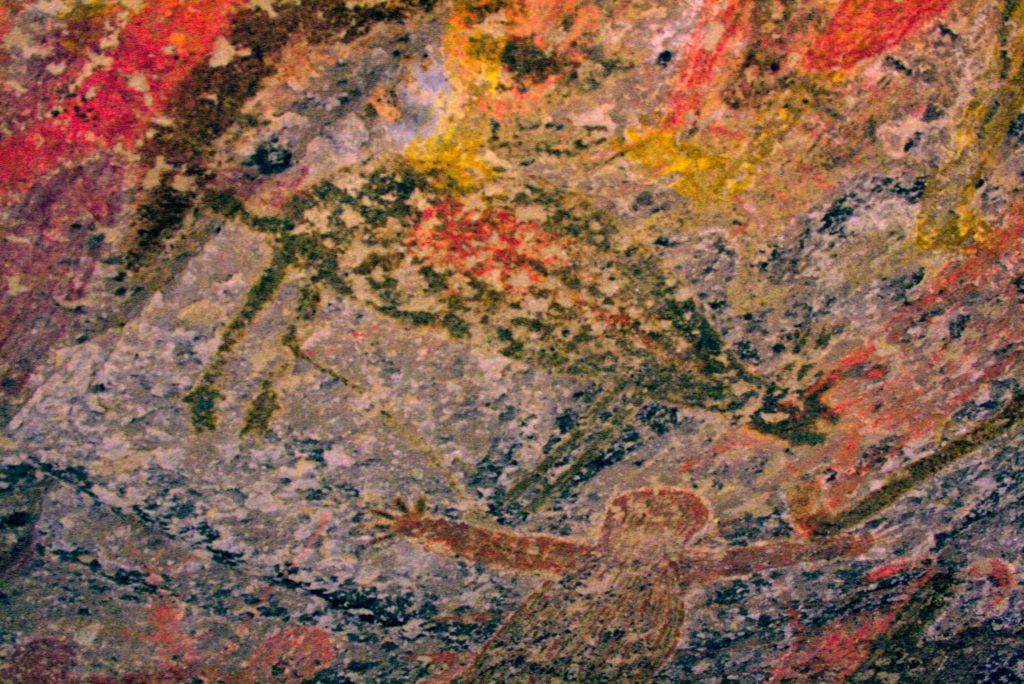
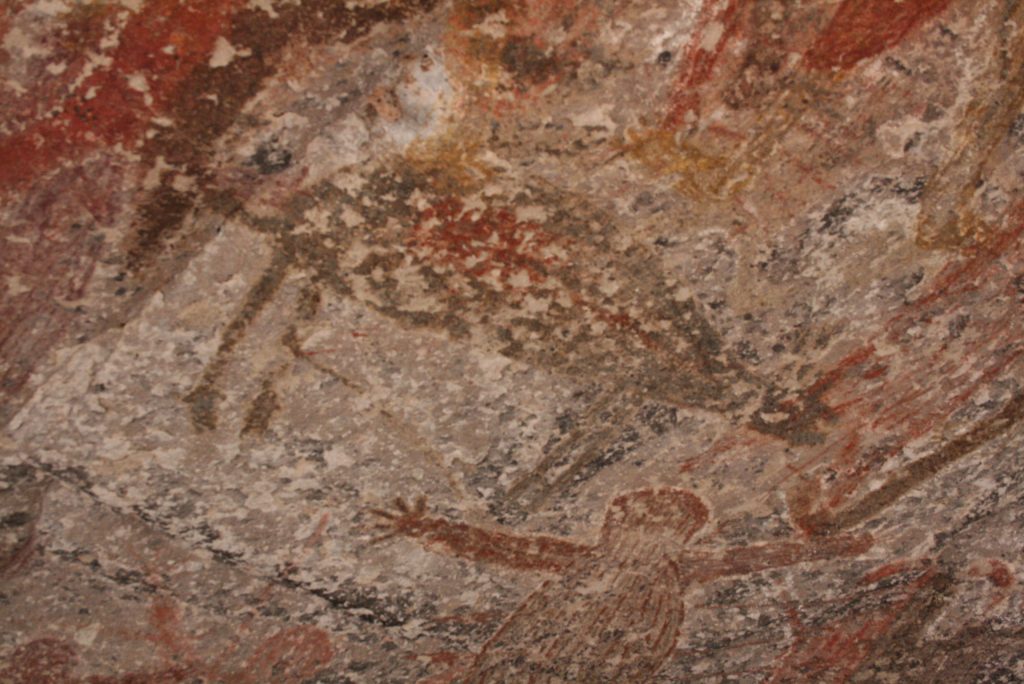
Photo B24_lbk shows a black deer, outlined in white with head to the right. There is a somewhat floral pattern of spirals in the interior of the deer connected to the mouth with a red line (the life line). Is this portraying the internal organs or spiritual essence of the deer? Notice the dewlaps on the rear feet. Notice also a ‘projectile’ terminating on one of the deer’s legs. Notice that on the mono below the deer the fingers are painted black.
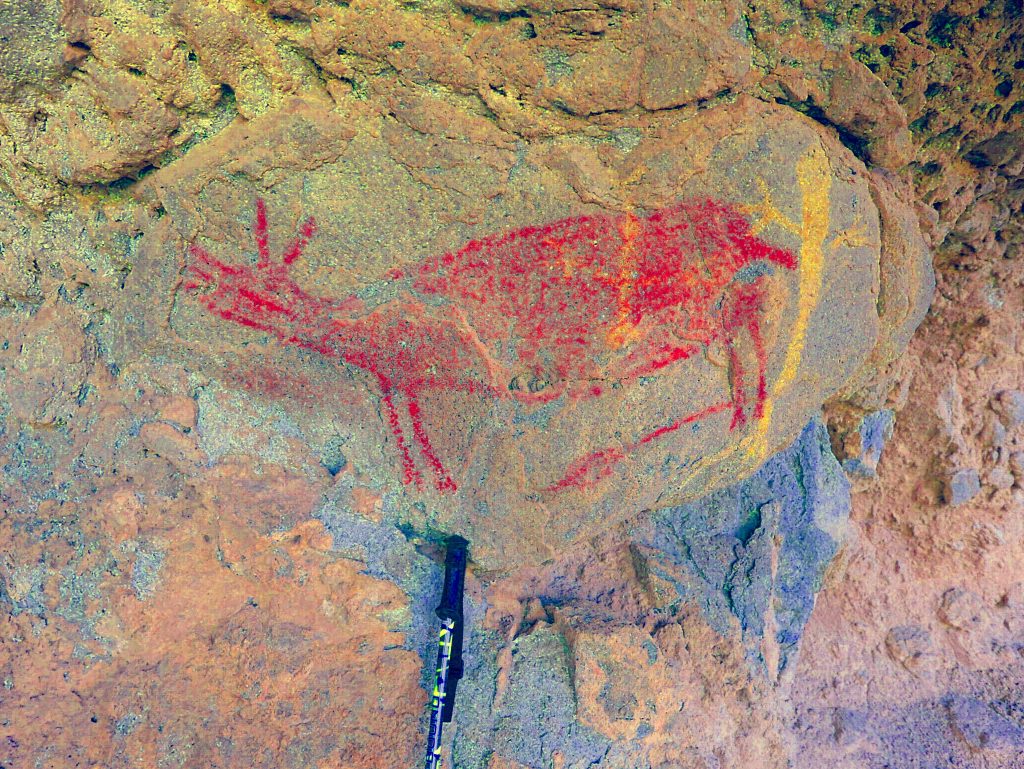
Compare the photo above to this photo taken in the Dos Venados cave (my name) in the San Juan arroyo 38 kms to the south. The deer is shown with a dart or arrow terminating at the leg, not penetrating it. A coincidence or is this depicting some characteristic of a hunt? Could these two pictures be by the same painter? Hmm! I promised I wouldn’t editorialize!
This photo, B 27, shows a male mono with black and red striped head and red striped body impaled with a dart through the torso. The fissure crossing the body has been painted in red also.
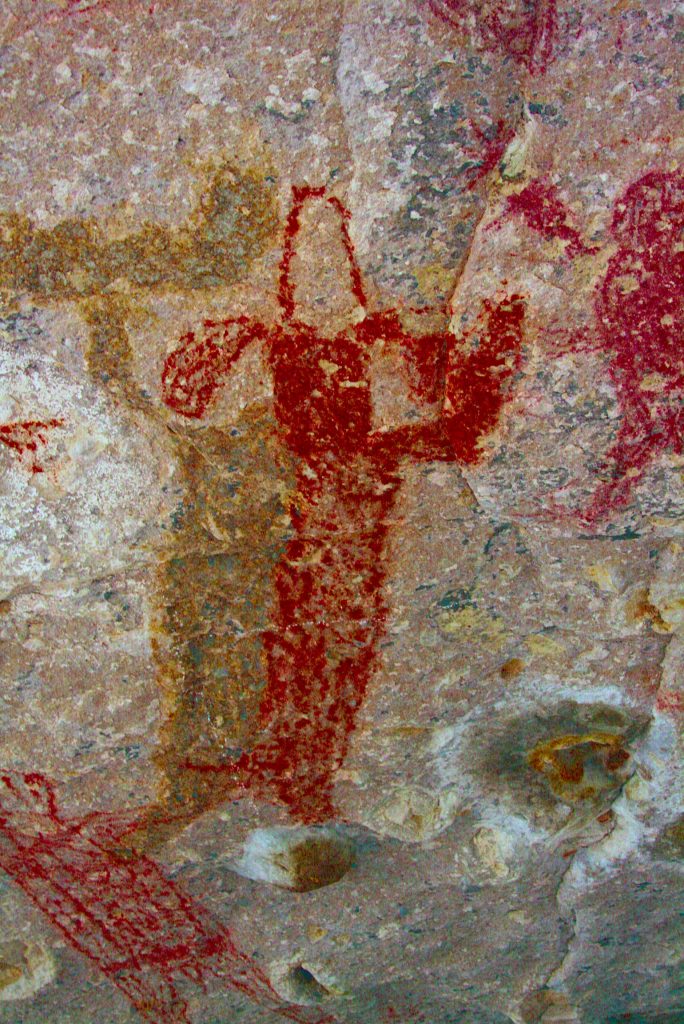
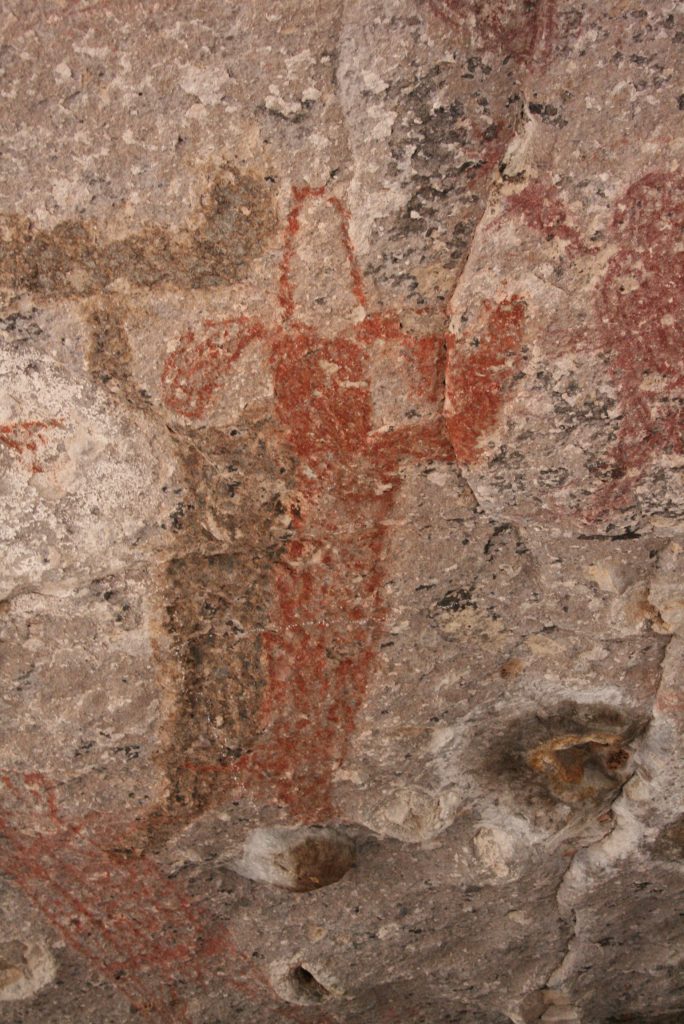
B28_lrd is photo on the right. Have some fun with this one! A black and red mono, outlined in white, with floppy ear headdress. There is a red conical shaped headpiece between the floppy ears. Also, there may be a bump on the elbow of the left arm, or it might be a fan? Being held up in the right hand is a long black sinuous object. A snake perhaps? If the head of the snake is on our right, are there eyes shown on the top of the raised up portion of the body? No darts penetrating this mono. So gentle readers, could it be that this painting was the last one painted (ie the youngest ) at this location and was never defiled by the slings and arrows of others? Or maybe. . . nobody messes about with “Snake Man”!
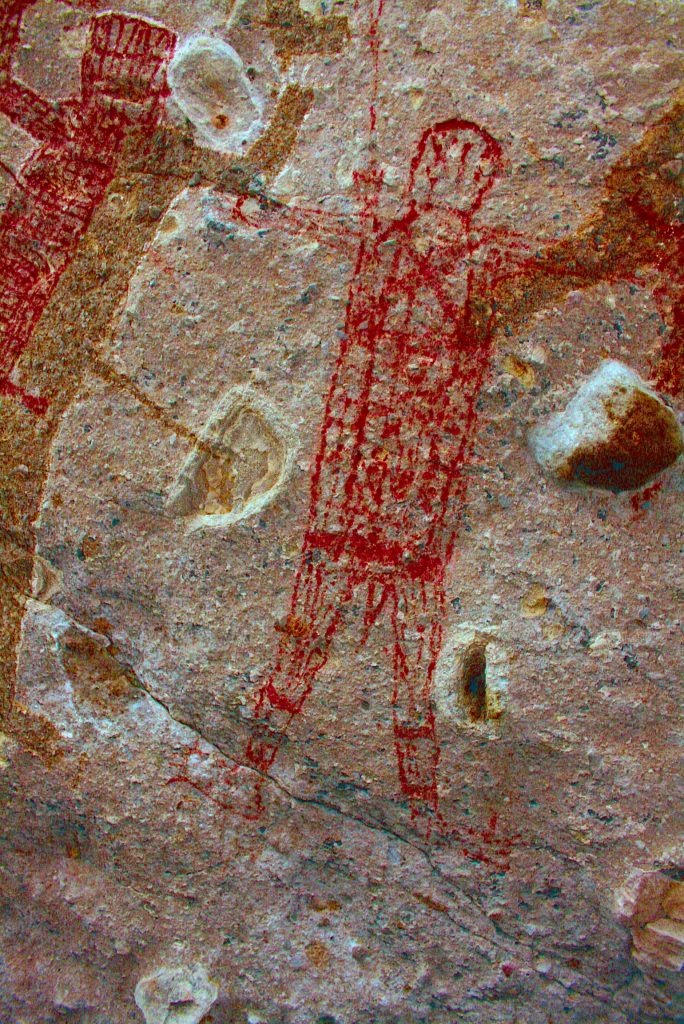
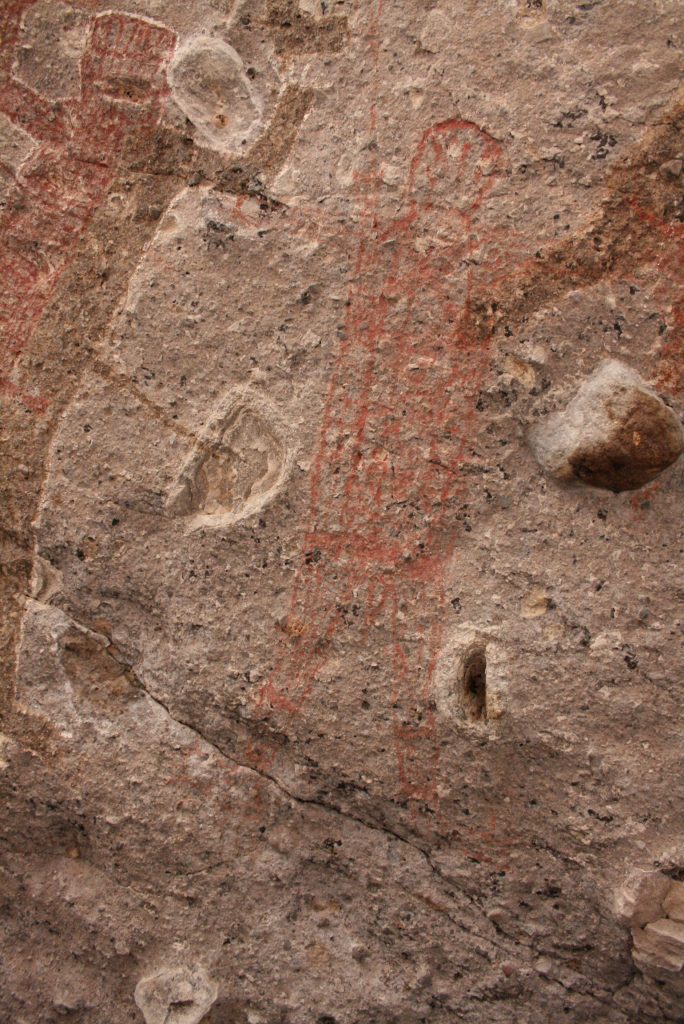
This Mono has some items of interest. A bandolier marking across the chest area. Tucked into the bandolier is a hammer shaped object with a long head. Maybe it’s a club type of weapon, perhaps a wood shaft with a sharpened length of deer antler? “Belt” marking positioned low on the elongated torso. Obvious phallic member with one round object on each side. (I wonder what those could be?) Markings on legs below the knee similar to gaiters. Longitudinal lines on body and legs. There may be some extra markings in the middle of the torso, perhaps signifying internal organs? Toes evident on both feet. Fingers not visible. Round head with markings for eyes and ? Large arrow/dart terminating at the right shoulder. I wonder about the significance of a dart that terminates/touches but doesn’t penetrate?
Two overlapping Monos. The lower one with conical head and ghostbuster eyes, Red and Yellow and outlined in white. No legs?
The upper Mono with a Can head outlined in black with small black appendages on each side where ears might be. Torso is Black and Red, not outlined. Inside of figure filled with dots rather than lines.
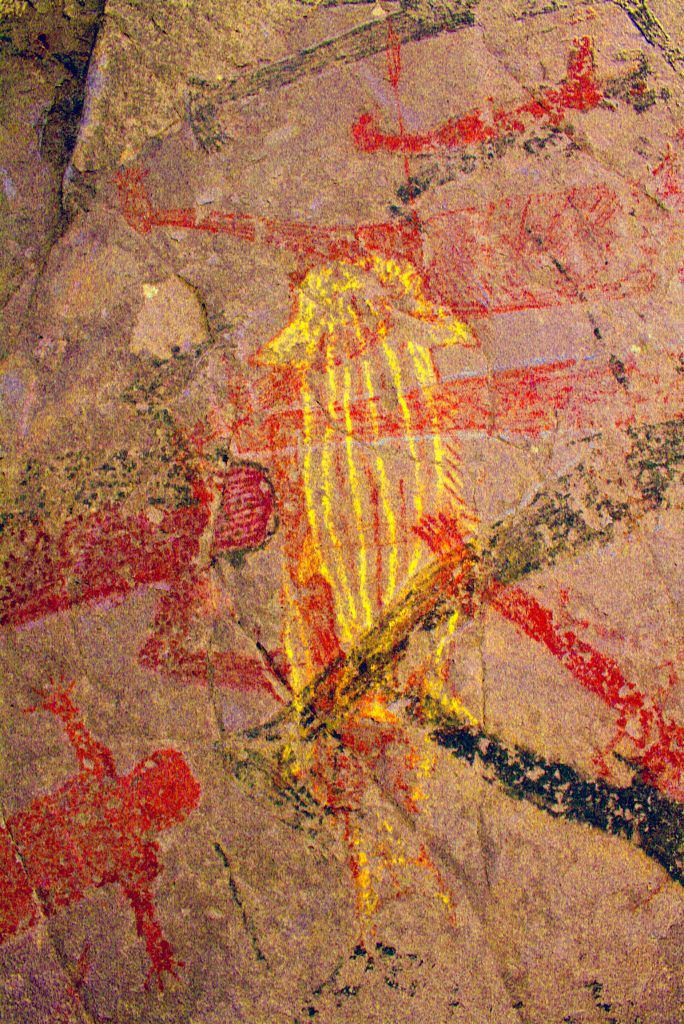
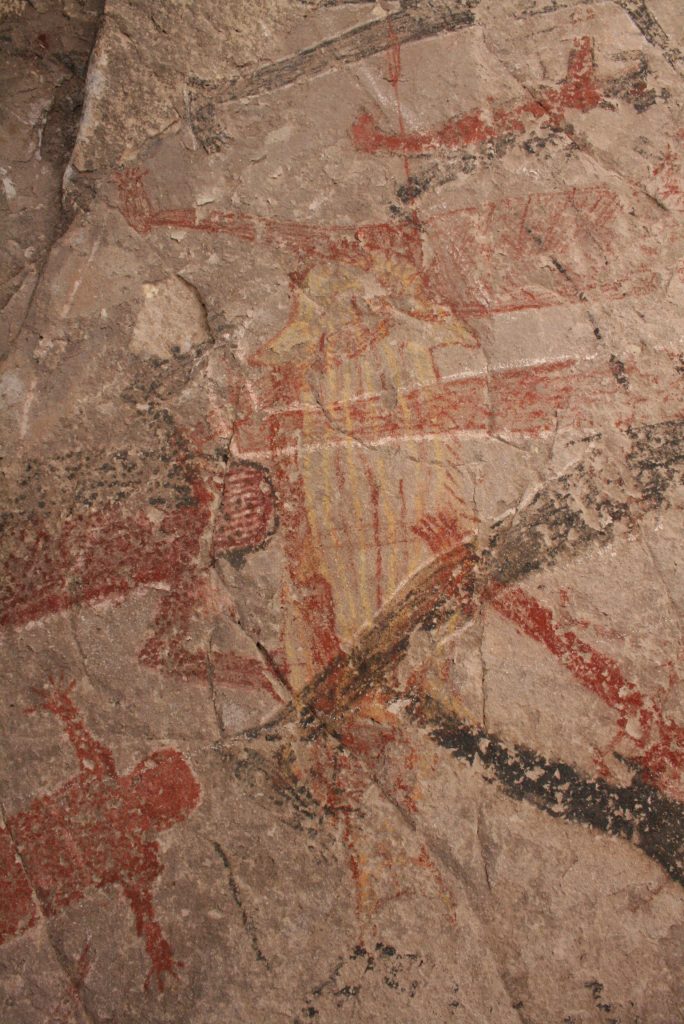
photo on right B 35_ac_lre
The un-retouched photo shows an object outlined in yellow that is not a Mono. The enhanced version may lead you to think that the object is a fish, perhaps a whale or maybe a seal with the head facing up in this photo. There are only a few other marine pictographs at this location and this is the first pictograph of this shape that I’ve seen. Hmm? Also, is it my imagination or does the animal look like it is passing/swimming between the legs of the Mono to the right of the photo? (Underneath the black leg and over the red leg)
This Mono is unique in this location as it is the only one portrayed with what seems to be a breast plate type of chest protector. Otherwise it is outlined in white with a Can head, black “ears” and four black vertical lines in/on head. The body has some longitudinal white lines visible. A dart or arrow penetrating the body. Hands and feet are not discernable. Bumps on the shoulders too.
This Mono has more rounded torso and legs than others at this site. Alternating Yellow and Red longitudinal lines in body. I count seven darts penetrating the body. His left hand is painted in white and appears ghostly.
This is a somewhat stylized Mono with hands, feet etc of varying proportions. Quite abstract. The left hand has 6 fingers. There is a bump on the right elbow. Three appendages on the oversized round head.
Michelin Man in this photo?
One of the few female Monos at this location.
This Mono clearly shows the bumps on the shoulders. Somewhere else on this website I believe I allude to the possibility that the wearer may be trying out for an NFL team. Hmm? Notice that the hands have been ‘ghosted’ out
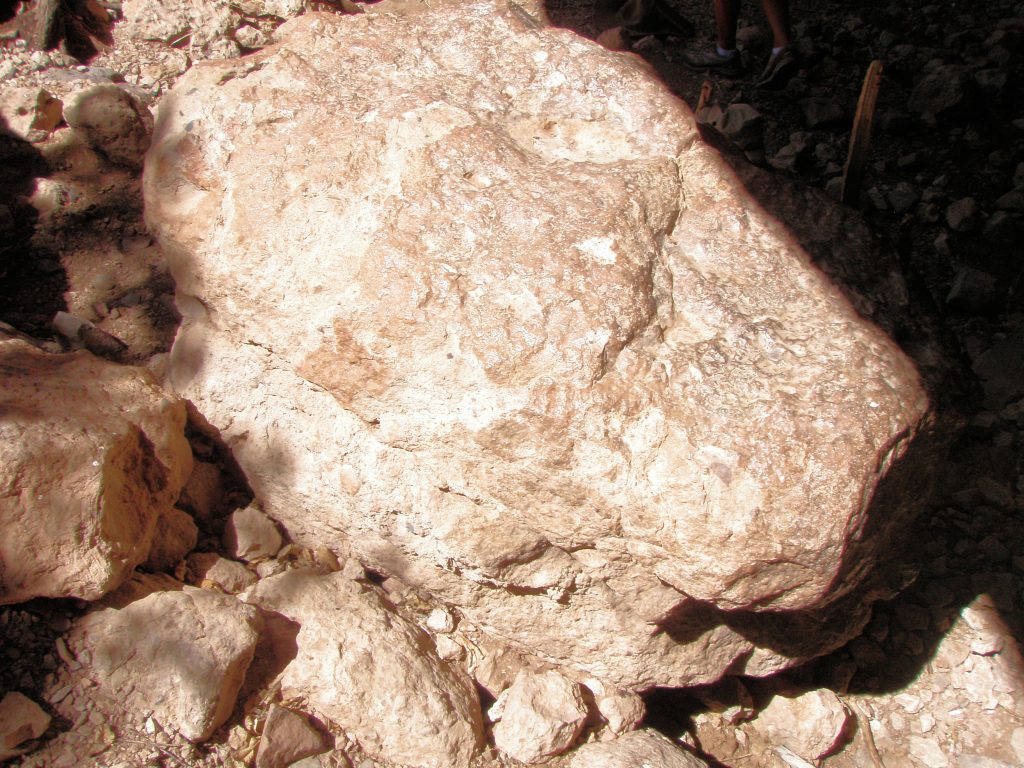
In the cave mouth there is a boulder of native rock about 3ft LxHxB that has a smooth brown finish on it that has a high shine. This finish has been noticed on similarly located boulders at other cave sites. I believe these to be “production” rocks where hides may be scraped and other food processing done. No other boulders here have this finish??
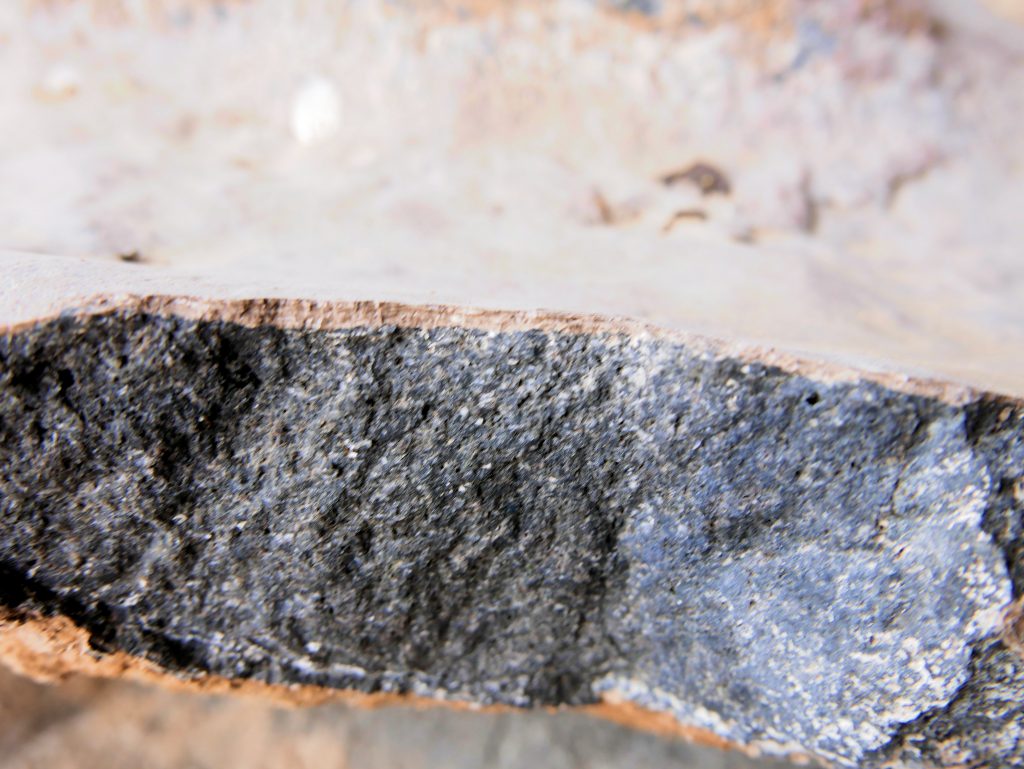
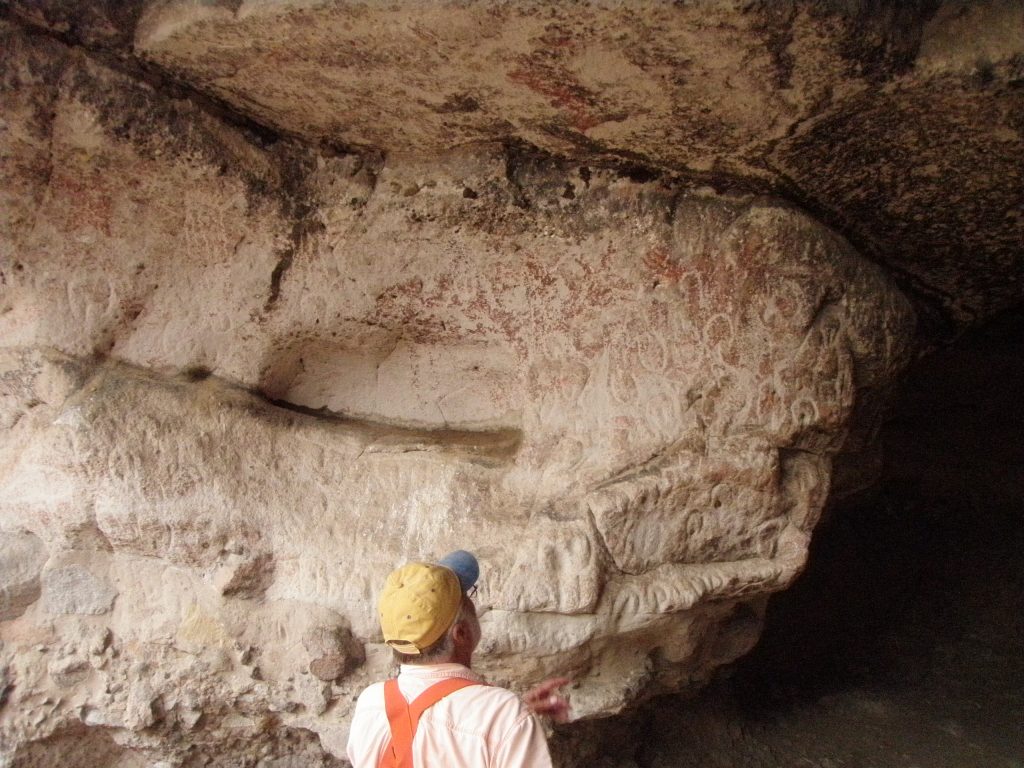
On the left side of the cave, close to the entrance is a wall that supports many, many petroglyphs of vulvas. The niche in this wall must surely have held significance to the Cochimi also.
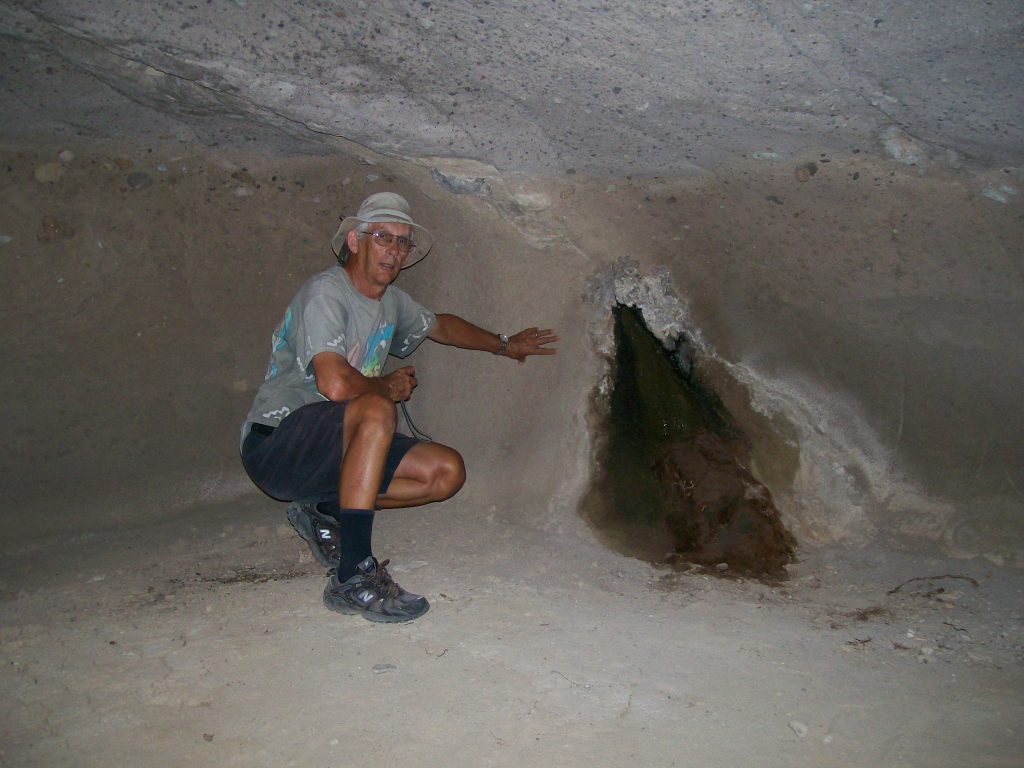
At the back of the cave is a “Yani” that was wet with water at the time of viewing the cave. This would have held some significance to the Cochimi and would have imparted a degree of importance to this particular cave.
There are many, many paintings to examine in this cave. I have visited three times and find something new each time. If you decide to visit this fabulous site, try to manage your time to get as much time at the cave site as possible. You won’t regret it!
Author at back of cave.
Consider the lines that you see drawn on the Monos in the pictographs in the San Borjitas cave and elsewhere. Did they exist on the humans of that time or were they a figment of the artist’s imagination? You be the judge!
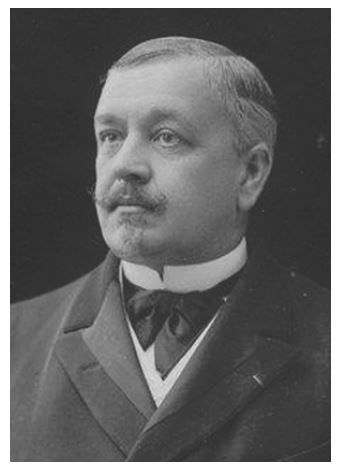
Leon Diguet 1859-1926
He worked as an engineer for the french El Boleo copper mine at Santa Rosalita in 1889. He returned to France after his tour of duty with the mine and subsequently returned to Baja in 1893-1894 to lead an expedition into the interior of the country to search for and document natural history, archeology and ethnography. He was shown the San Borjitas site (probably by the Jesuit Padres at the mission in Mulege) and it is listed as #63 Diguet 1895. He described the rock art therein and classified it as “Cochimi Representational”
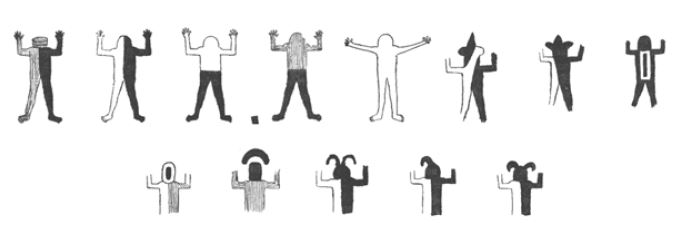
Above are diagrams from Leon Diguet’s notes where he describes the Monos from the Mulege area. Recognize any?
This concludes the section on San Borjitas

